|

Old Clouth firm
Logo

"CLOUTH"
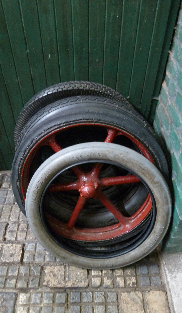
Altreifen


Balloon Gondola

Cöln Beginning of 20
Century.

Franz Clouth
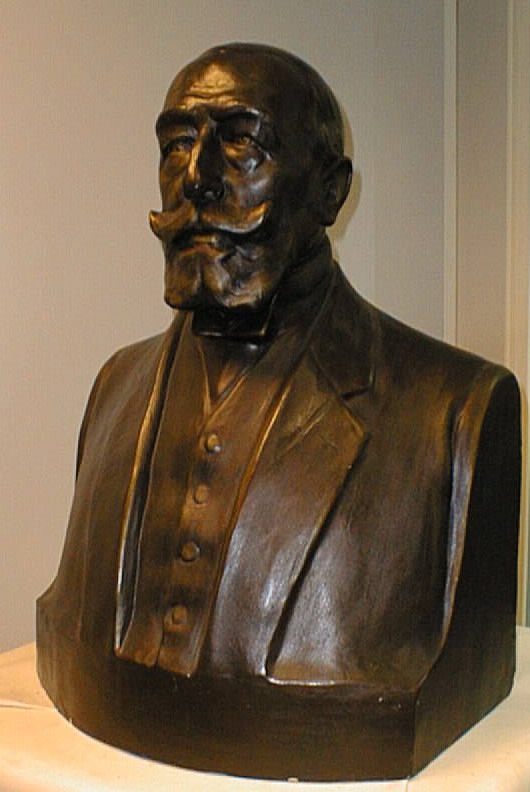
Bronze F. Clouth Bust
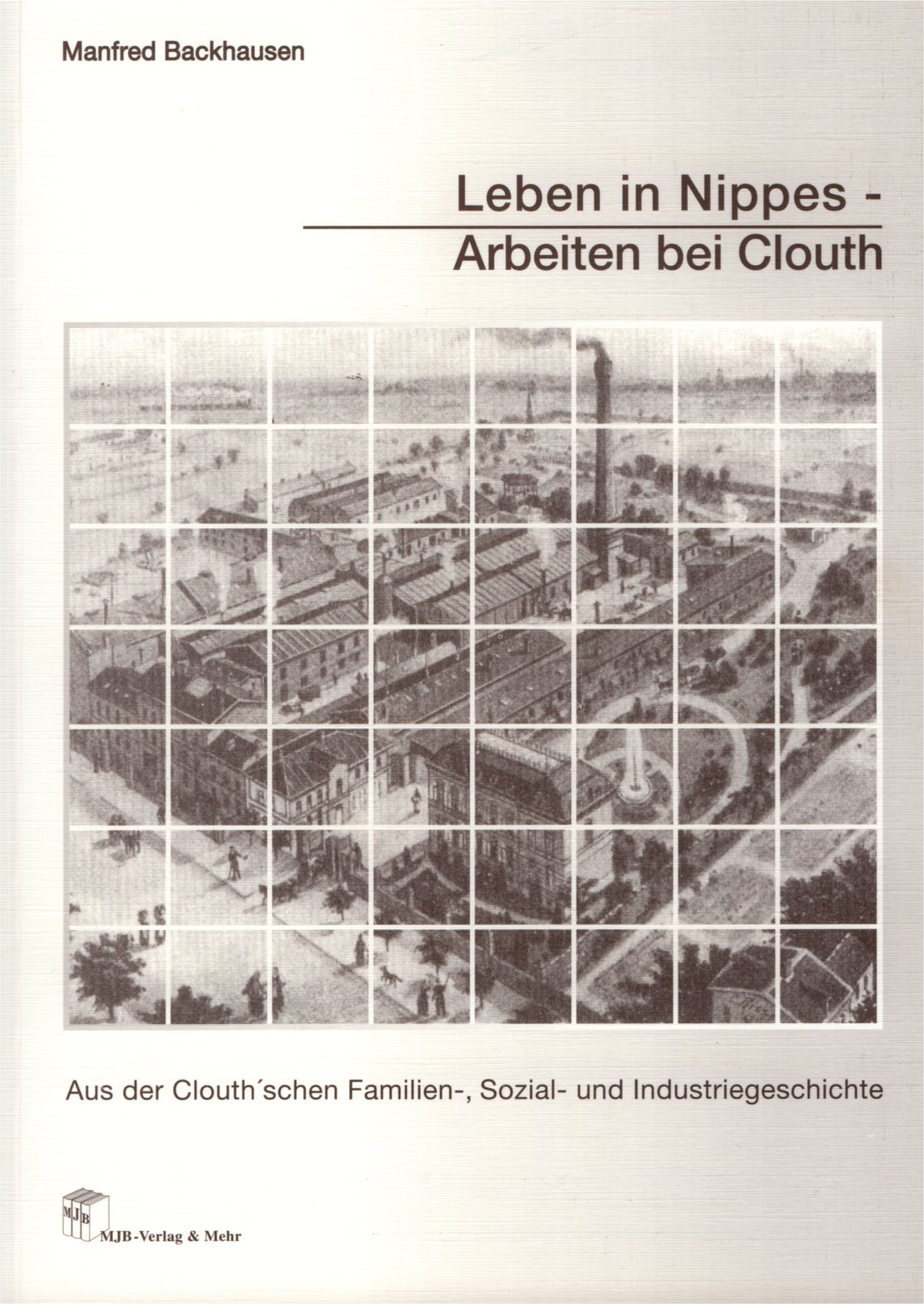
Clouth Book Nr.1
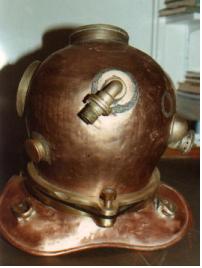
Diving Helmet Clouth
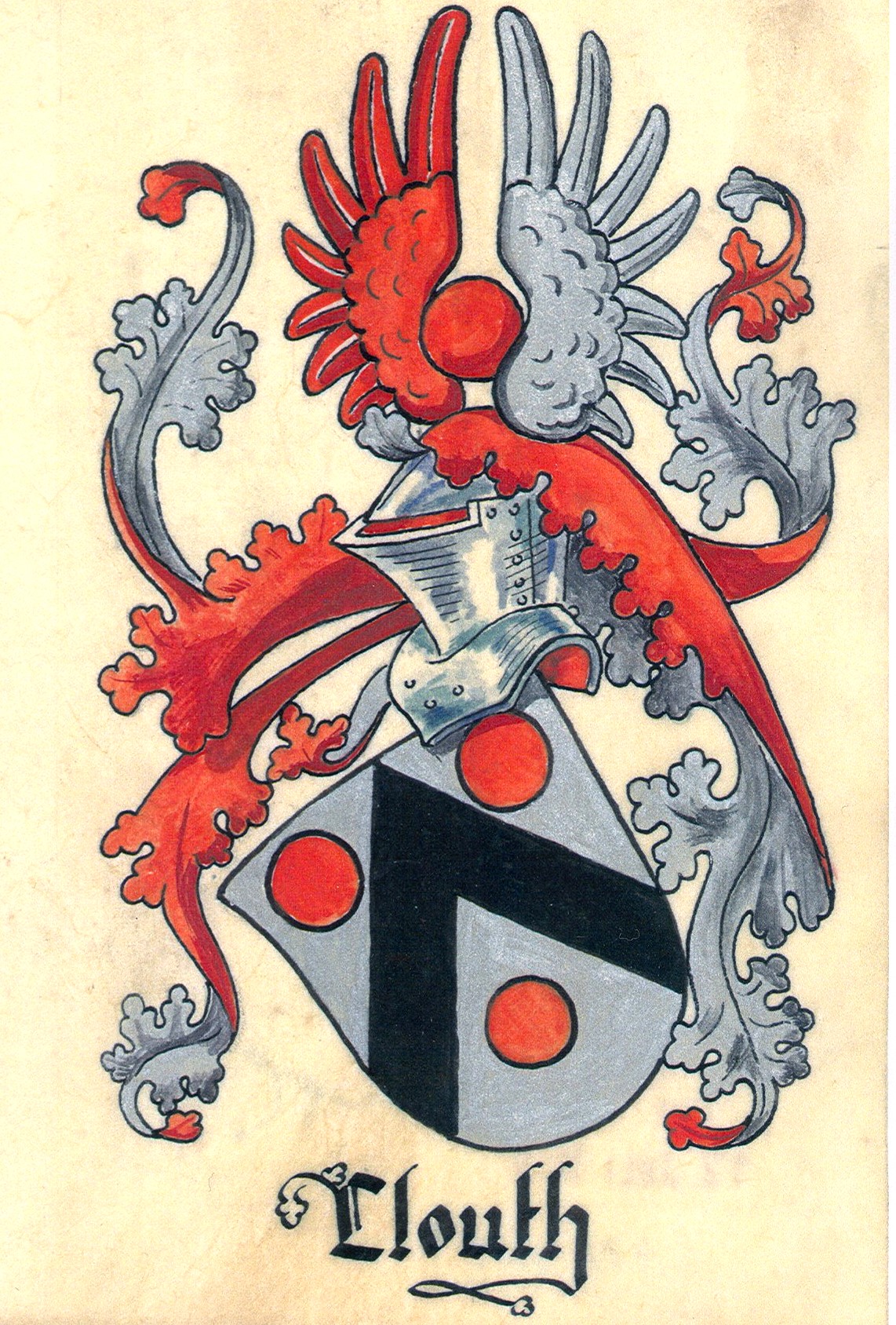
Clouth-Wappen 1923
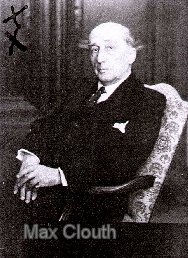
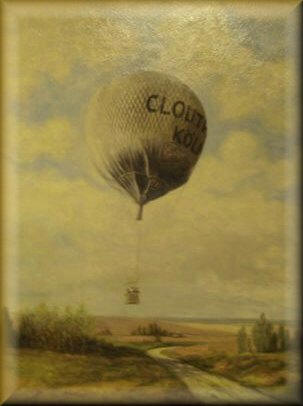
Clouth Balloon XI
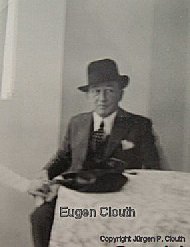
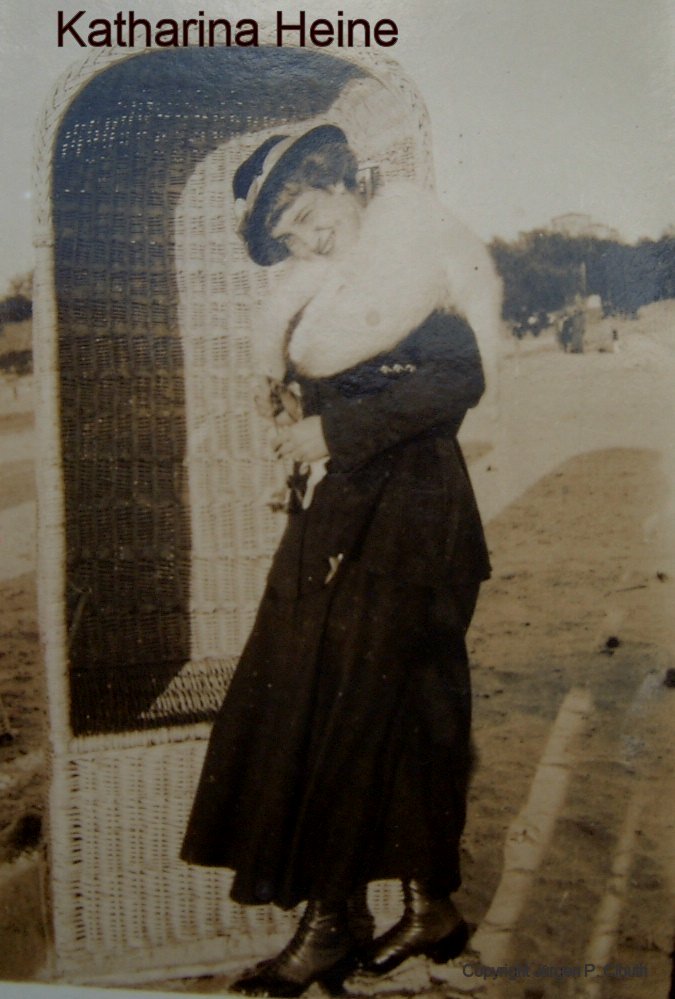
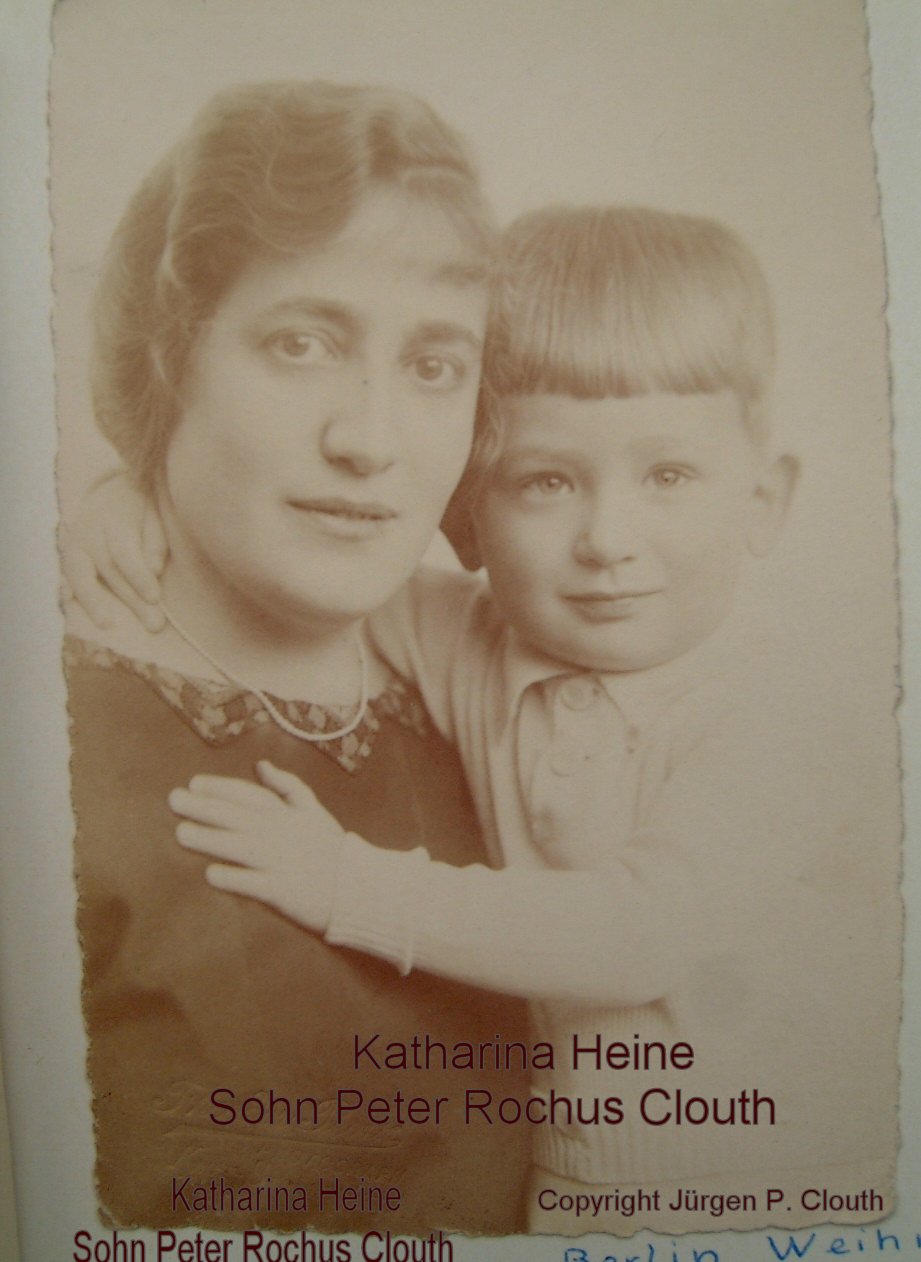
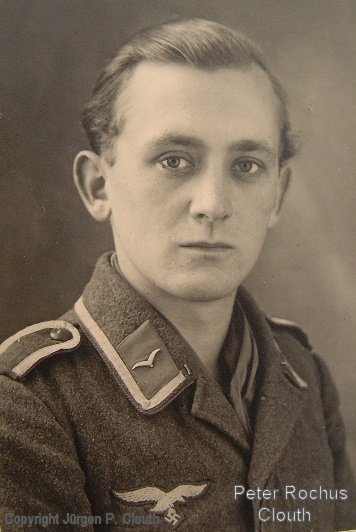
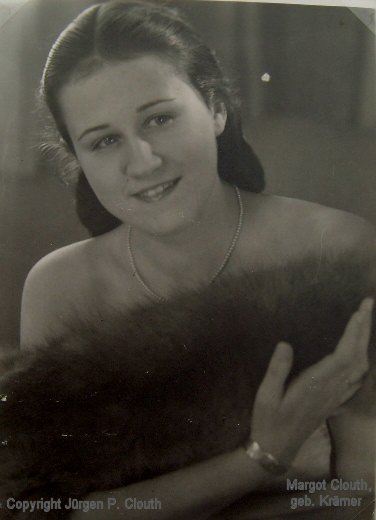


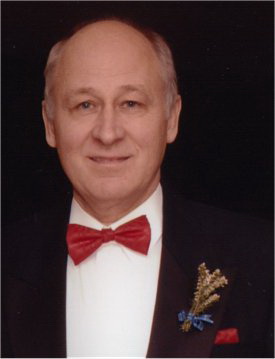
Rechtsanwalt J.P. Clouth
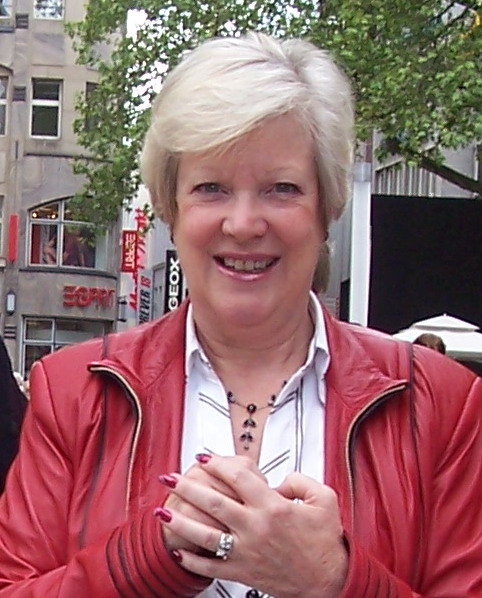
Ehefrau Audrey Clouth

Bryan, Oliver, Phillip
Clouth
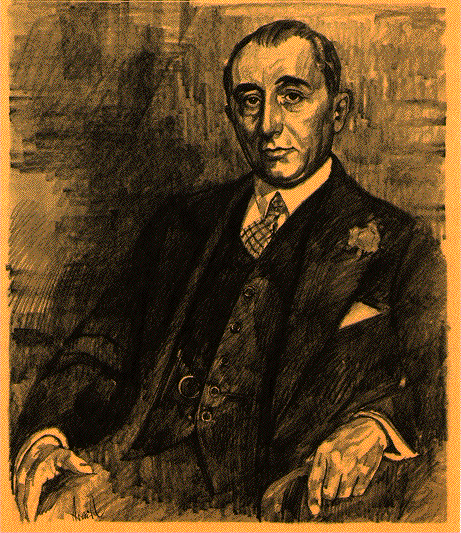
Max Clouth

Clouth Balloon Sirius
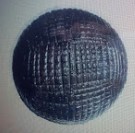
Kautschuk Golfball
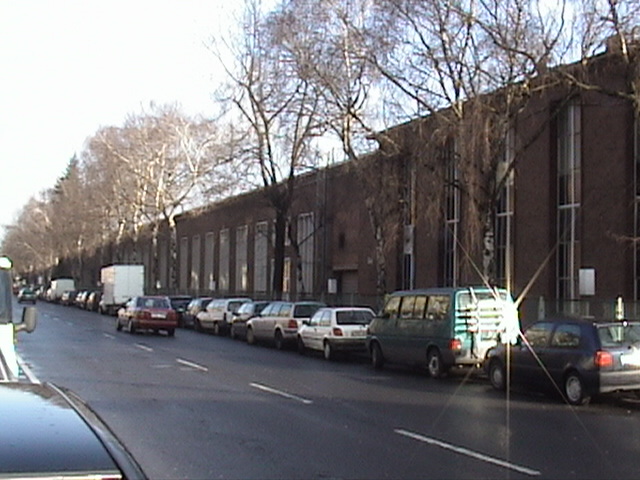
Clouth Factory Front

Younger Franz Clouth

Eugen Clouth
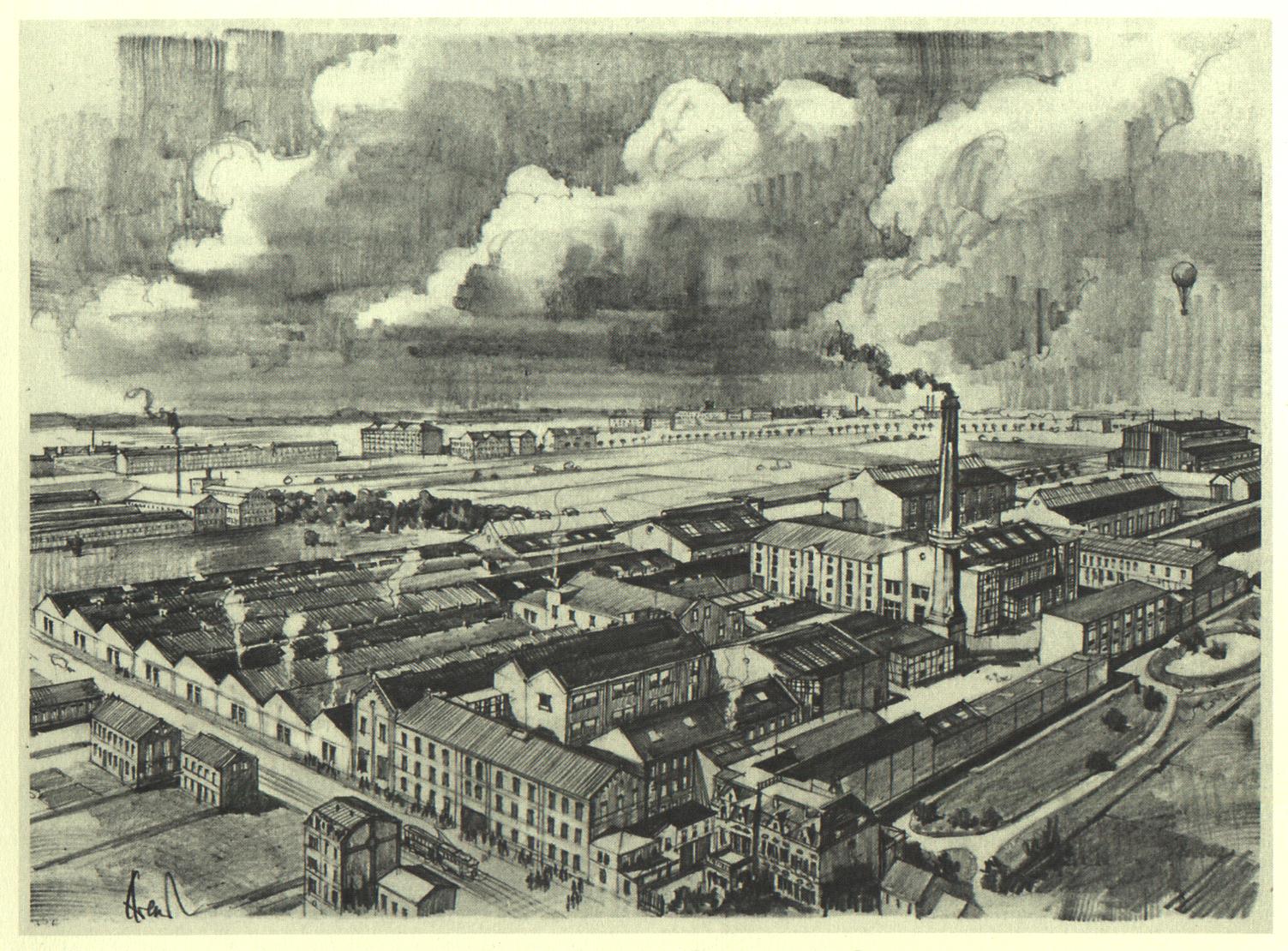
Clouth Factory

Air Ship Advert

Clouth Money
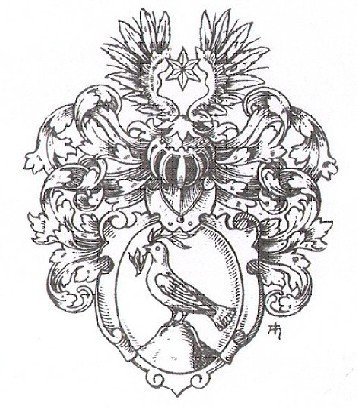
Old Clouth Crest
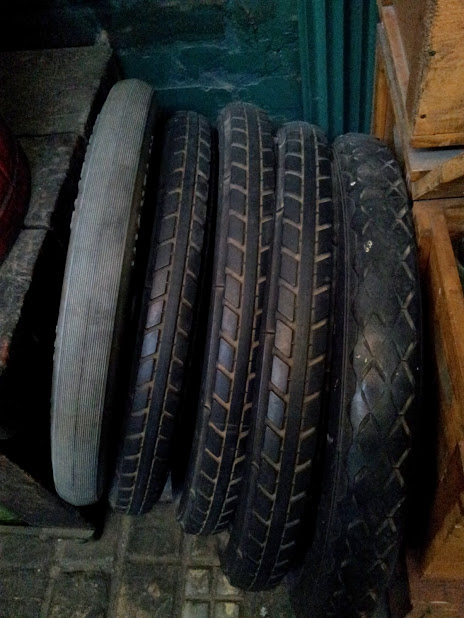
Car tyres
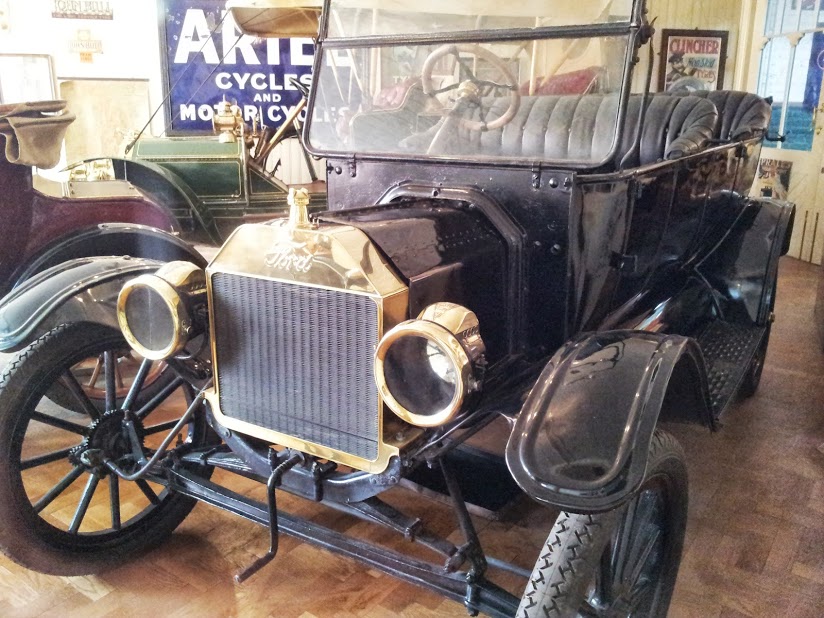
Old Car
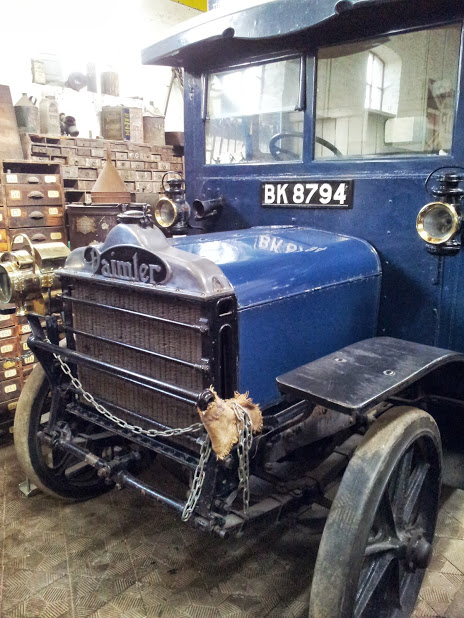
OLd Daimler

Excavator with conveyor
belt

Clouth VIII Balloon
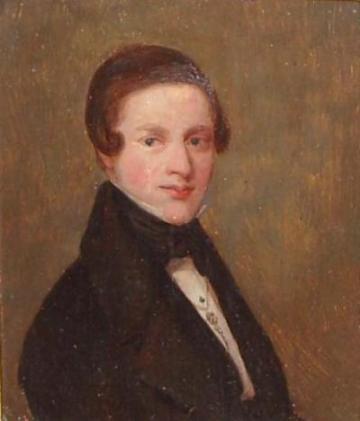
Wilhelm Clouth
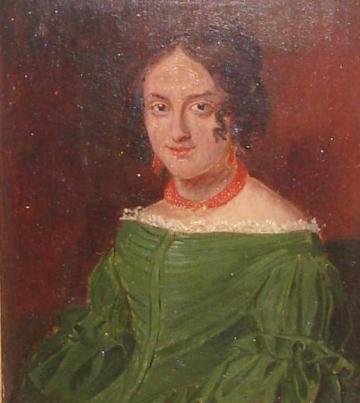
Katharina Clouth

Caoutchouc Golfball

Draft of Clouth Memorial
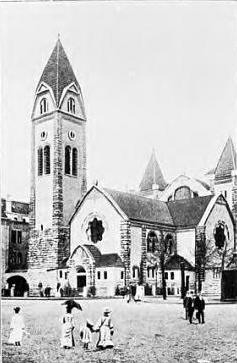
Old Catholic Church Köln

Cable Tower
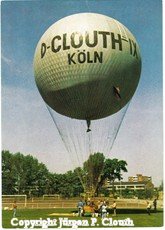
Clouth IX

Ticket for Clouth IX
Drive
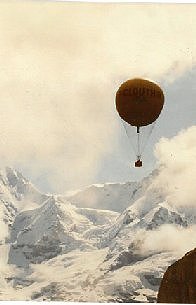
Clouth IX
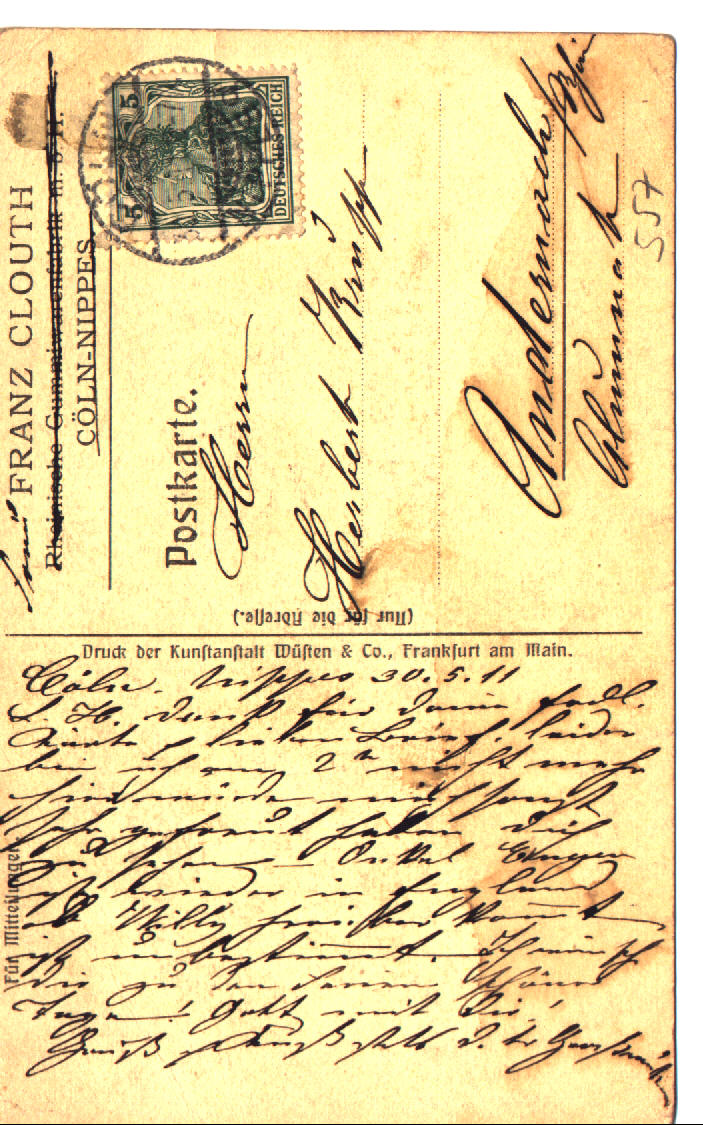

Clouth Buch 2.Edition
.jpg)
old Franz Clouth

Balloon Gondola
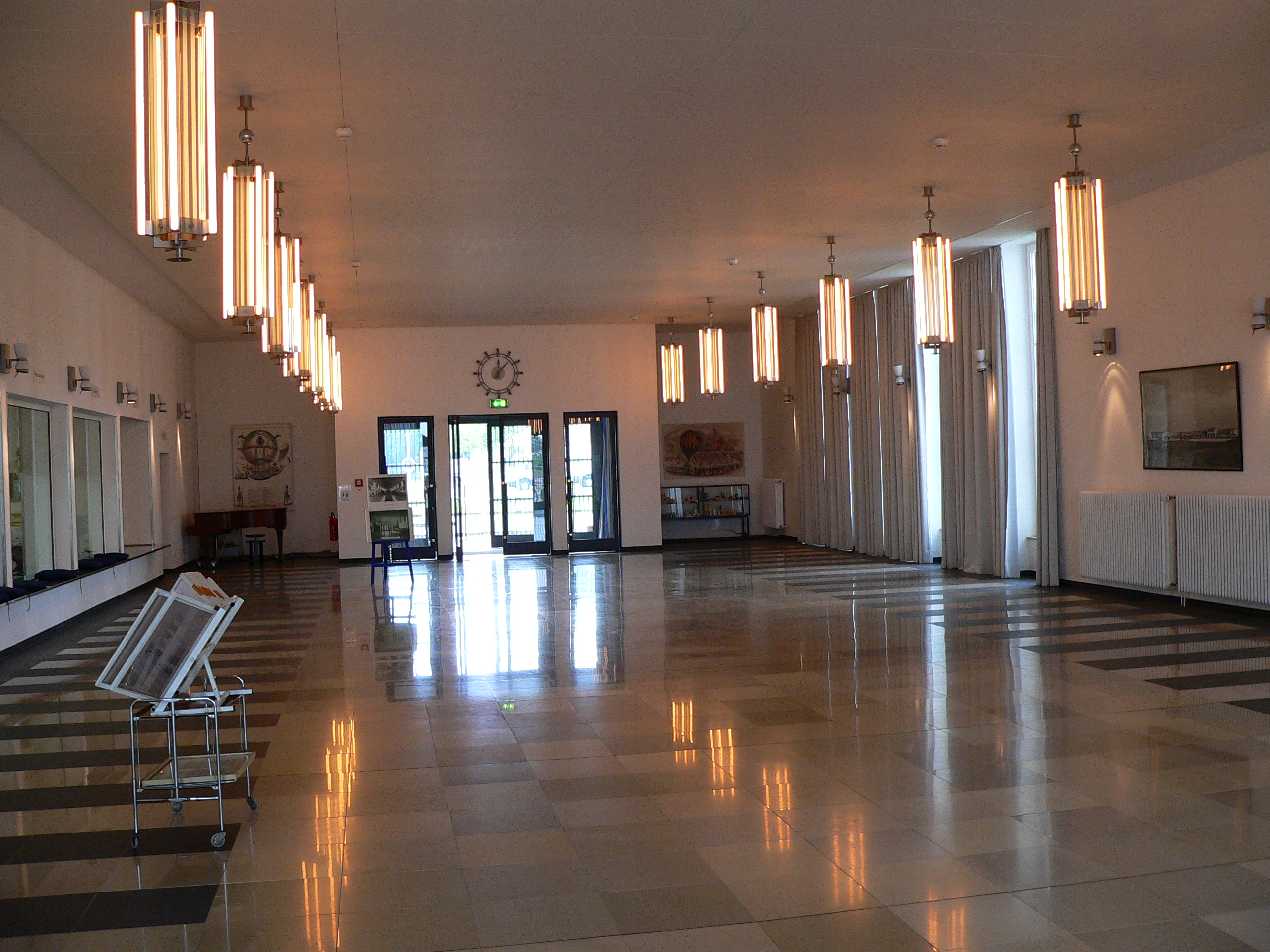
Butzweilerhof Airport
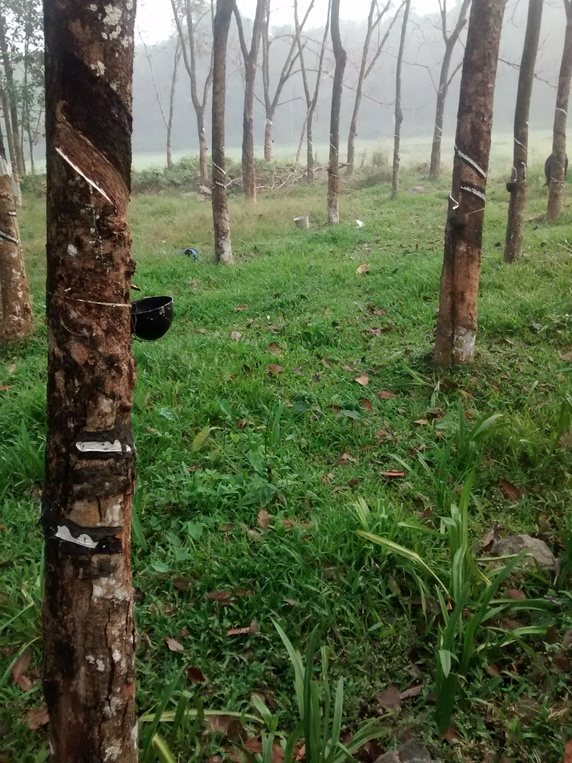
Caoutchouc-Tree
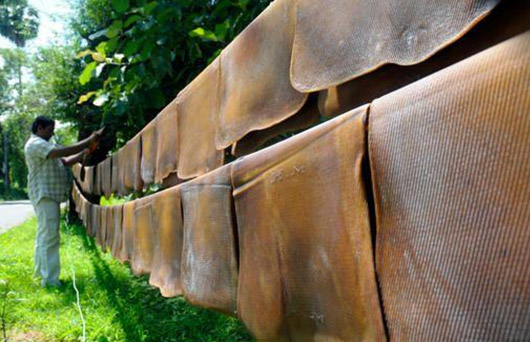
Caoutchouc Sheets
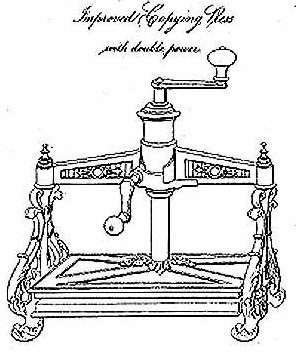
Caoutchouc-Copy Mashine

Water-Regulator
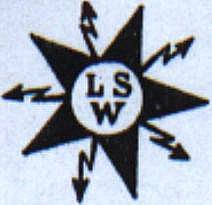
old Land & See Logo
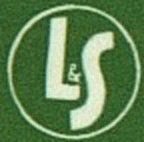
Land & See New logo
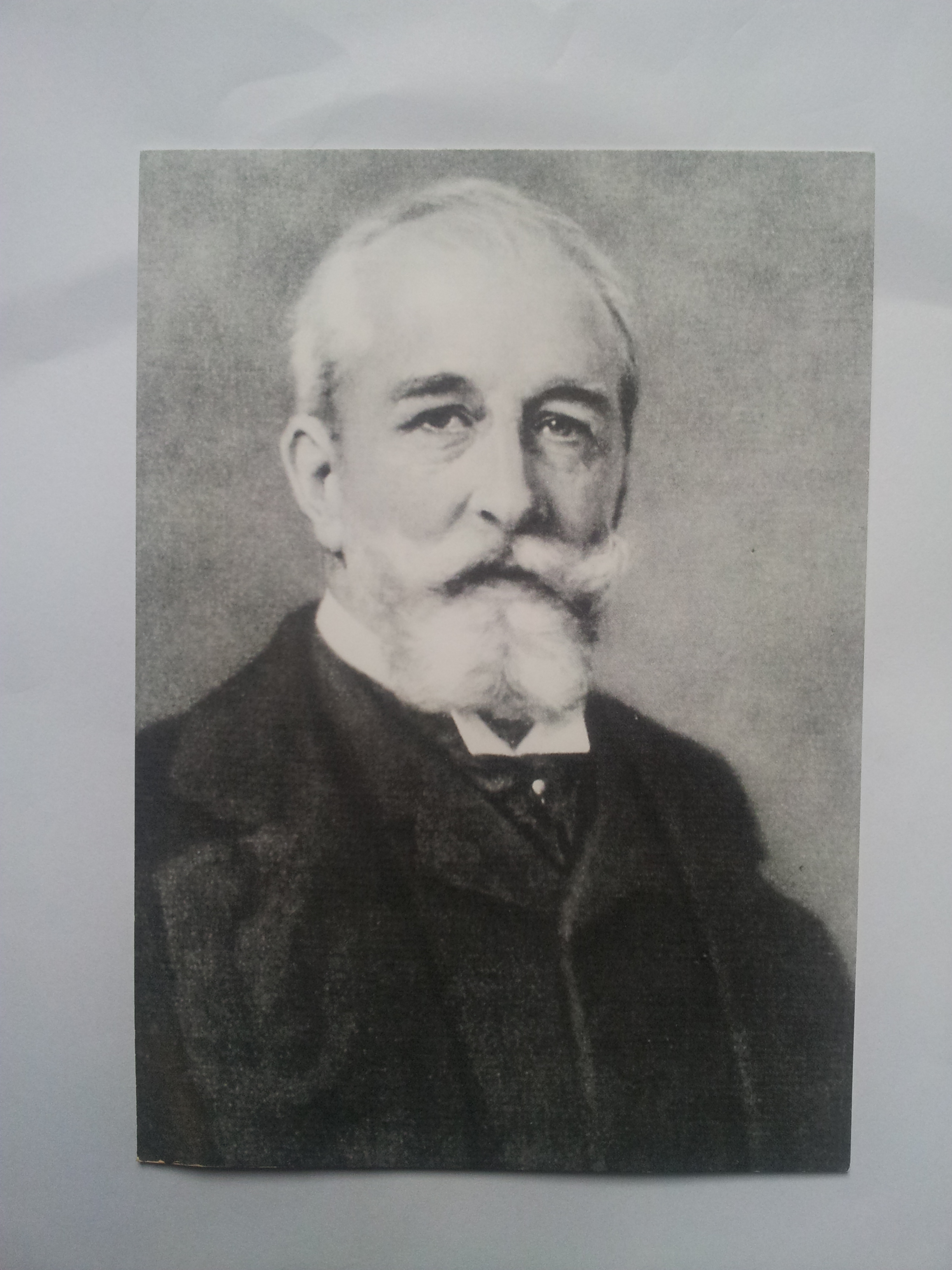
Franz Clouth

Richard Clouth

Industrieverein Altlogo


Conveyor Belt Hall

Gate 2 to Clouth Works

Atlantic Cable
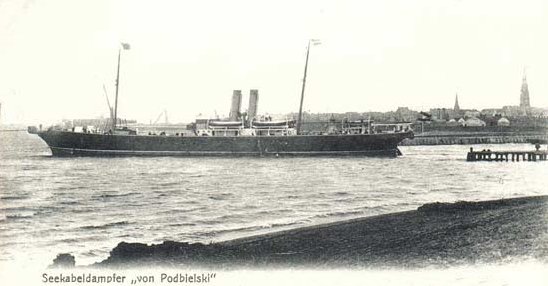
von Podbielski Cable
Layer
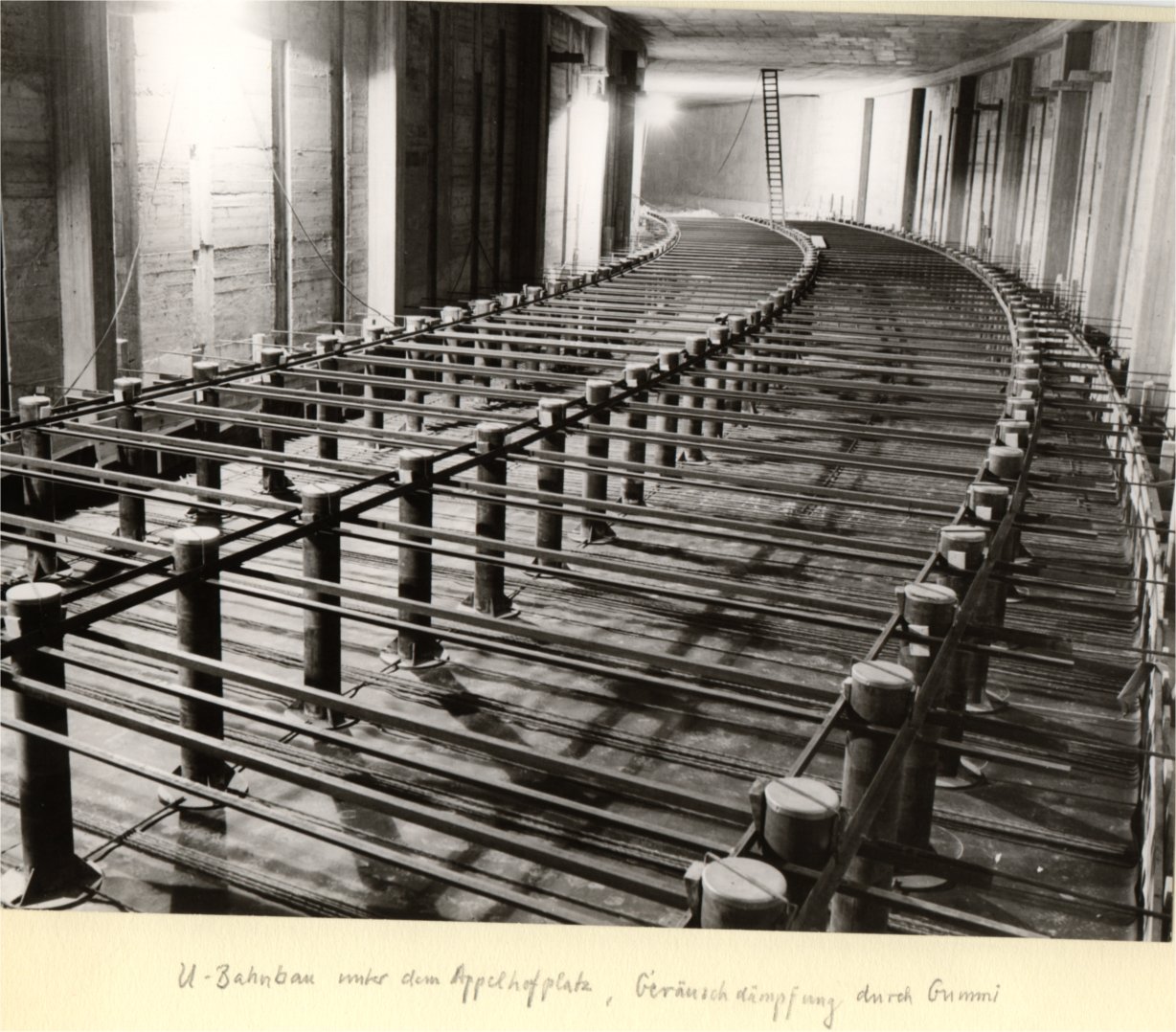
Sound Silencer "Clouth
Ei"(Egg)

Printery Wilhelm Clouth
| |
airship aviation

 
dirigible/airship Clouth
Beginnings
of the aviation exhibition
-
History
-
History in general
-
The air travel history of Cologne and the
region, part 1
-
Reference:
Krause, Thorsten: The aeronautical history of Cologne and the region, part
1. The beginnings of ballooning and airship in Cologne until 1912. With an
escort by Dr. Edgar Meyer, president of the foundation Butzweiler Hof
Cologne. In: Pulheimer Contributions to History and Home Based Learning
2002, vol. 26, pp. 199-231.
-
From the rigid airship "Z1" Graf Zeppelins
to the dirigible airship "CLOUTH"
-
Connections to Graf Zeppelin
-
Emperor's emblem of the Emperor's coat of
arms; No noble predicate like "von" Clouth
-
Airship and balloon
history


Airship travel 1909
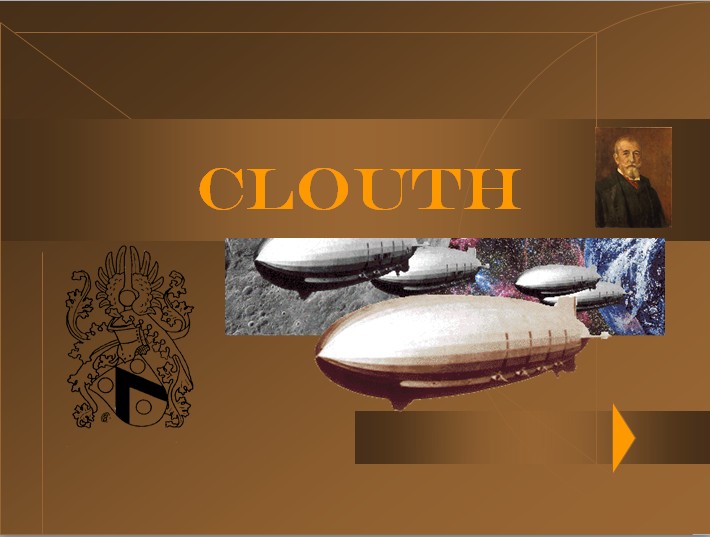


-
-
From rigid airships like Z1
to dirigibles like "CLOUTH Airship"
-
-
-
 Deutsches Luftschifffahrt-Museum
Deutsches Luftschifffahrt-Museum
The first ascent of a manned balloon in Germany took place on 3 October 1785 in
Frankfurt am Main. [3]
The Frenchman, Jean-Pierre Blanchard, introduces a series of ballooning
demonstrations on German soil, making the balloon travel widely known in the
German Reich. [4]
 In the following the history of the beginnings of the balloon and airship in
Cologne until 1912 is sketched.
Starting from the end of the 18th
century.
This chronological demolition closes with the founding of the military air
station "Butzweilerhof" in 1912.
The focus of the description is on the aircrafts "Lighter than Air" and the
related events within the cathedral city.
Especially
the "Freiballon" (no scaffolding errection) is up to the beginning of the 20.
century the only
aircraft of importance;
Airships or airplanes - later dominant - have not yet been fully developed, as
there is still a lack of suitable propulsion for these aircrafts.
The beginning of the "Motorfliegerei" (engined objects) in Cologne with the
aircraft "heavier than air" is largely excluded in the context of this
consideration.
That chapter in Cologne's history of aviation requires a separate presentation,
as it is just as complex as event-driven and flight pioneers, like this one,
which is to be described here. In the following the history of the beginnings of the balloon and airship in
Cologne until 1912 is sketched.
Starting from the end of the 18th
century.
This chronological demolition closes with the founding of the military air
station "Butzweilerhof" in 1912.
The focus of the description is on the aircrafts "Lighter than Air" and the
related events within the cathedral city.
Especially
the "Freiballon" (no scaffolding errection) is up to the beginning of the 20.
century the only
aircraft of importance;
Airships or airplanes - later dominant - have not yet been fully developed, as
there is still a lack of suitable propulsion for these aircrafts.
The beginning of the "Motorfliegerei" (engined objects) in Cologne with the
aircraft "heavier than air" is largely excluded in the context of this
consideration.
That chapter in Cologne's history of aviation requires a separate presentation,
as it is just as complex as event-driven and flight pioneers, like this one,
which is to be described here.
This presentation is mainly based on the documents and records compiled and
archived by the Butzweilerhof Foundation in Cologne [5]
In addition, general literature on the history of aviation as well as
corresponding documents from archives are used to round out the picture.
II. Civil and military balloon and airship
II. 1 Civilian balloon and airship
The first attempt to conquer Cologne in Cologne, which however remained
unsuccessful, is handed down for the year 1785.
When Jean-Pierre Blanchard arrives in Cologne on October 21, 1785, on his round
trip through the German Empire, the latter sends a request to the city to be
allowed to rise in the Rhine metropolis with his balloon.
The Cologne City Council rejected Blanchard's request: the city fathers argue
that it is presumptuous against God's mercy to do such things. [6]
The city of Cologne issues a start ban and allows the trained mechanic and
engineer only a public presentation of his balloon.
With the approval of the balloon ascent two and a half weeks earlier, the City
Council of Frankfurt a. Main was more open-minded than the cathedral city. [7]
The refusal of Cologne's mayor of the Cologne may be due to the fact that the
balloon was regarded as a symbol of enlightenment and technical progress, some
even as a sign of revolution and upheaval.
The predominantly bourgeois conservative population and the cathedral city,
which is concerned with peace and order, probably want to distance itself from
these political dimensions. [8]
Despite this concern on the part of the city, balloon climbs can not be
completely removed from the surrounding countryside of Cologne or the Rhineland.
[9]
In May, June and July, 1788, the Land Physician of the Monheim Office, Georg
Haffner, opened a balloon of his own design in Deutz. [10] Haffner announced his
plan in advance by means of a newspaper. [11]
Only after clearing out some concerns of the archbishop of Cologne and Elector
Maximilian Franz, a Deutzer Amtmann (civil servand) - Deutz was then still a
neighbor city of Cologne [12] - with permission of the Cologne Stadtherren
Haffner's permission for his balloon demonstration. [13]
Further balloon ascents from Haffner, whether without or with human occupation,
seem to have stopped.
According to Haffner's departure from Deutz, there are several letters of
complaint which the aeronauts are alleged to be in breach of payment. [14]
 Like the Frenchman Jean-Pierre Blanchard, the "balloonist of the first European
aviation enthusiasm" [15], Georg Haffner is one of the few professional aviators
at the end of the 18th century in
Europe.
He belongs to the group of showman aeronauts, who follow the example of
Blanchard and run the ballooning professionally from genuine enthusiasm.
Often they have to finance the construction of their balloons themselves from
the revenues of their performances.
At this time, only a few people are allowed to ascend.
The balloonists call themselves 'aeronauts' or to German 'Luftschiffer';
As "captains" they "ride" in the "air sea" and dress in marine uniforms. Like the Frenchman Jean-Pierre Blanchard, the "balloonist of the first European
aviation enthusiasm" [15], Georg Haffner is one of the few professional aviators
at the end of the 18th century in
Europe.
He belongs to the group of showman aeronauts, who follow the example of
Blanchard and run the ballooning professionally from genuine enthusiasm.
Often they have to finance the construction of their balloons themselves from
the revenues of their performances.
At this time, only a few people are allowed to ascend.
The balloonists call themselves 'aeronauts' or to German 'Luftschiffer';
As "captains" they "ride" in the "air sea" and dress in marine uniforms.
In the course of the 19th century,
Balloon demonstrations are gaining popularity by famous and less prominent
aeronauts.
In addition to the events in well-known amusement centers in front of an
'upscale' public, the balloon also plays an attractive role in the annual
markets and national festivals.
By enriching the previous flight program, parachute jumps and night trips, the
conditions for an increased and wider publicity of the balloon are created.
Initially it is mainly foreign aviatics who perform balloon demonstrations in
Germany: "Germany did not have balloons in the 19th century either of international reputation. "[16]
Accordingly, numerous climbs are also taking place in Cologne mainly by French
and English aeronauts.
The aeronauts Sinval and Guerin could have organized such demonstrations in
Cologne in April and May of 1808.
In the Cologne newspapers "Gazette Française de Cologne" and "Der Verkündiger",
they are often advertised. [17]
In this, they announce their intention to get a balloon, from which Monsieur
Guerin will then jump with a parachute.
At the beginning of May, 1847, the Englishman Charles Green [18] gave a guest
performance in the cathedral, where he carried out two ballooning competitions.
[19]
During his stay, Green presents his balloon with an improved parachute for
sightseeing.
Green is one of the most famous and successful aeronauts of the 19th century.
In his self-designed 'Royal Vauxhall balloon' he succeeded on 7th /
November 1836 a spectacular journey from London to the Duchy of Nassau.
In March, 1878, Gustave Landreau, an aviatist from Brussels, asked the Cologne
police chairman to be allowed to rise in the city together with his colleague,
Palont, on May 15 and 19, 1878. [20]
A remarkable personality of the Cologne balloon history of the late 19th century
is Maximilian Wolff.
The learned bookbinder master is one of the founding members of the "German
Association for the Promotion of Air Navigation", founded in Berlin on September
8, 1881, the oldest organization of aviation-inspired people. [21]
In 1889 Wolff was again found in Cologne as an engineer and executive director
of the "Ballon-Sport-Club Cöln, founded 1888".
In 1890, he founded the "Verein zur Förderung der Luftschiffahrt, Cöln" as a
counterpart to the Berlin predecessor and became the chief editor of the
collection "Das Luftschiff" [22].
Since the 1880s, the Aeronaut has been running a permanent attraction in the
Riehler "Golden Corner" (Goldenes Eck) [23] by balloon flights with passengers,
which make it well known across the borders of Cologne.
Thus, Wolff uses his practical knowledge
in the field of air shipping to earn money.
Spectacular is the performance in the late evening of June 10, 1889, during the
"General Exhibition for Household Supplies and Food" in the Riehler "Golden
Corner". [24]
On an approximately 50 m long rope his balloon 'Hohenzollern' draws a
"compilation of different fireworks bodies", according to the report of a
Cologne newspaper [25].
At some altitude Wolff ignites numerous colorful light-bulbs that illuminate
the sky above Cologne.
Two days earlier, Wolff had a misfortune in the course of the "International
Sports Exhibition" [26] taking place there at the same time: his balloon
'Colonia' burst during filling, the smaller one was launched in a hurry with the
name 'Schwalbe'.
About a year later, on July 7, 1890, Wolff once again passed a mishap, this time
with more serious consequences: On a trip from Cologne to Bensberg, his balloon
'Stollwerck' is captured during the landing by a sudden wind breeze.
This ripped one of the eight agricultural workers who helped with the landing,
the passenger Peter Schmitz, who is still in the basket, among other things,
President of the Blue Spark, as well as Wolff himself.
Shortly afterwards, the farmhand crashes and is seriously injured, Peter Schmitz
and Wolff can later leave the balloon uninjured.
Following these events, the authorities are accused of neglecting the lives of
their passengers. [28]
Obviously, the spread of this type of balloon accident, which is the subject of
numerous articles of the time, [29] sensitizes the population.
The authorities are increasingly demanding that similar investigations should be
avoided in the future.
On May 19, 1894, the Cologne police chief received a letter in which he was
warned not to grant permission to a balloon lift in Cologne to the aeronaut
Robert Feller, Ferrel. [30]
According to the author of the letter, Feller is jeopardizing his passengers
because of his drinking habits.
What specific measures are being taken is not known;
A year later, Ferrel is again to be found in his professional career in the
Riehler "Golden Corner". [31]
Here, "Captain" Ferrel appears together with the well-known air bailiff "Miss
Polly".
"Miss Polly", which is called Luise Giese née Schleifer, belongs to the few
(besides the well-known Frankfurt parachute artist and balloonist
Käthe Paulus) women in
this trade. [32]
Since both women appear in matry costumes and bear the artist name "Miss (with
two 's') Polly" or "Miss (with 'ß') Polly" and are thus only to be distinguished
by their different notation, they are frequently confused.
Both aeronauts are in the Rhineland, and they are also offered engagements in
numerous cities abroad.
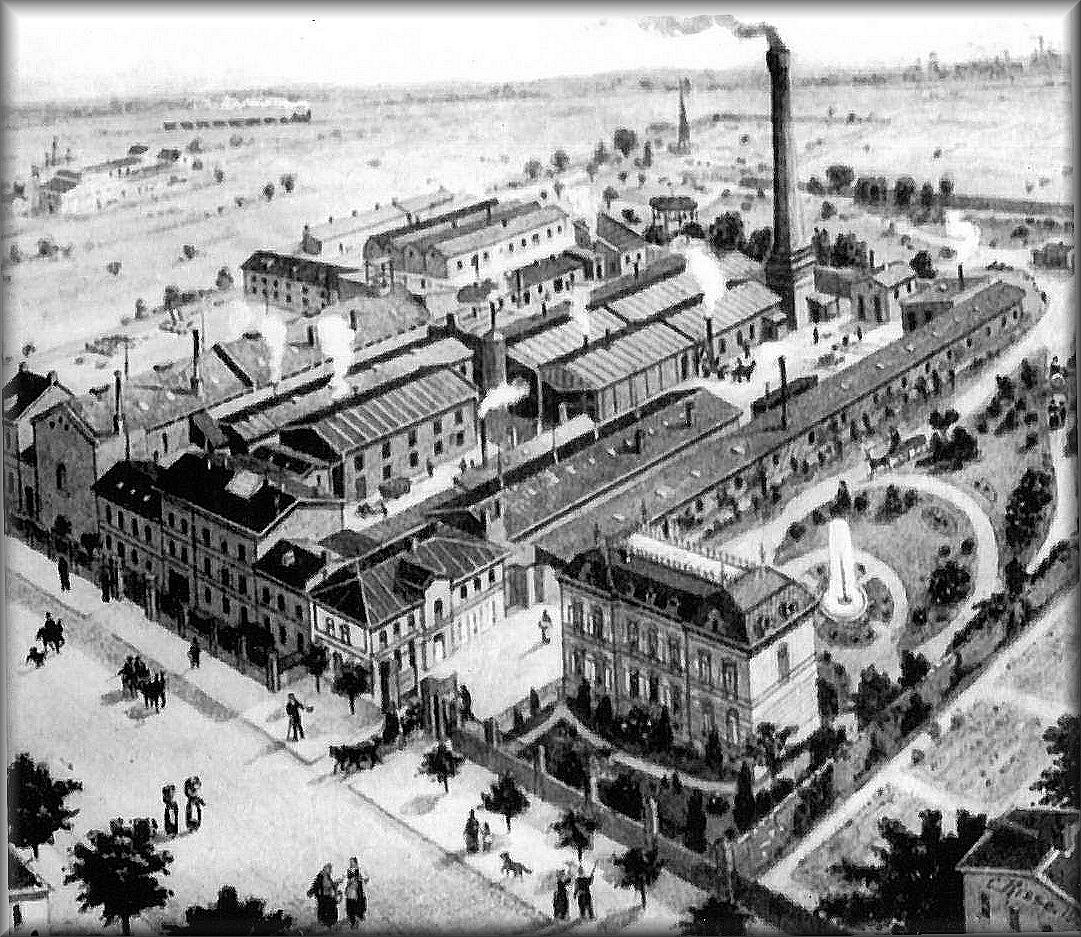 The
Cologne-based manufacturer Franz Clouth made an important contribution to both
the Cologne and the general development of aviation as well as the urban
industrialization process with his company "Franz Clouth Rheinische
Gummiwarenfabrik Cöln-Nippes".
At the end of the 19th century, the company, which was founded in 1862 and has
been producing rubber products of all kinds, is dedicated to the manufacture of
balloon materials and complete balloons, as well as the development and
construction of a
dirigible like "CLOUTH
Airship.
[36]
As early as 1908, the airship 'Clouth I' undertook his maiden voyage over Nippes.
For the development and construction of the airship about one and a half years
were required, all parts except the engine were custom made of the company
Clouth.
For the construction of 'Clouth I', 1907 the probably first architectural
testimony of a - in the broadest sense - air transport architecture in Cologne:
a 45 m long, 29 m wide and 17 m high airship hall was erected on the factory
premises in Cologne-Nippes
Corporate balloons and the airship later served as a "home port." [37]
In 1909 the The
Cologne-based manufacturer Franz Clouth made an important contribution to both
the Cologne and the general development of aviation as well as the urban
industrialization process with his company "Franz Clouth Rheinische
Gummiwarenfabrik Cöln-Nippes".
At the end of the 19th century, the company, which was founded in 1862 and has
been producing rubber products of all kinds, is dedicated to the manufacture of
balloon materials and complete balloons, as well as the development and
construction of a
dirigible like "CLOUTH
Airship.
[36]
As early as 1908, the airship 'Clouth I' undertook his maiden voyage over Nippes.
For the development and construction of the airship about one and a half years
were required, all parts except the engine were custom made of the company
Clouth.
For the construction of 'Clouth I', 1907 the probably first architectural
testimony of a - in the broadest sense - air transport architecture in Cologne:
a 45 m long, 29 m wide and 17 m high airship hall was erected on the factory
premises in Cologne-Nippes
Corporate balloons and the airship later served as a "home port." [37]
In 1909 the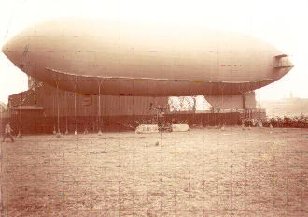 Cloudsche Luftschiff could be visited at the "Internationale
Luftschiffahrts-Ausstellung" (ILA) in Frankfurt/Main, next to constructions of
Zeppelin, Parseval and Ruthenberg.
During the numerous ascents during the exhibition visit, it turned out that the
control of the airship had to be modified.
Several provisional changes had already been made in Frankfurt, but only after
the return to Cologne the airship received a completely revised control system.
The
ship gained considerable maneuverability.
At the 1910 World Exposition in Brussels, the airship also undertook a trip,
where it completed several round trips and was awarded the prize for airships by
the flight committee of the exhibition. [38]
In total, the 'Clouth I' had carried out more than 40 trips, covering almost
2.000 kilometers;
This fact proved the operational safety and usability of this type.
A second airship was never developed, as the company Clouth is beginning to
withdraw from the area of air shipping as early as 1910. [39](interest
of military directed more into upcoming aeroplanes).
In addition to the construction of their own airships, there were also some
balloons from the Clouthian production, which have entered into the history of
aviation and pioneered. [40]
Cloudsche Luftschiff could be visited at the "Internationale
Luftschiffahrts-Ausstellung" (ILA) in Frankfurt/Main, next to constructions of
Zeppelin, Parseval and Ruthenberg.
During the numerous ascents during the exhibition visit, it turned out that the
control of the airship had to be modified.
Several provisional changes had already been made in Frankfurt, but only after
the return to Cologne the airship received a completely revised control system.
The
ship gained considerable maneuverability.
At the 1910 World Exposition in Brussels, the airship also undertook a trip,
where it completed several round trips and was awarded the prize for airships by
the flight committee of the exhibition. [38]
In total, the 'Clouth I' had carried out more than 40 trips, covering almost
2.000 kilometers;
This fact proved the operational safety and usability of this type.
A second airship was never developed, as the company Clouth is beginning to
withdraw from the area of air shipping as early as 1910. [39](interest
of military directed more into upcoming aeroplanes).
In addition to the construction of their own airships, there were also some
balloons from the Clouthian production, which have entered into the history of
aviation and pioneered. [40]
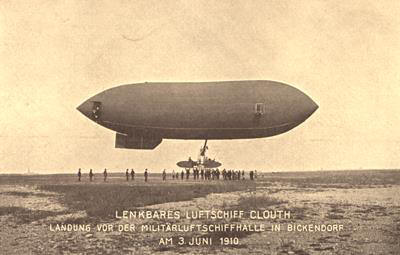 The art of ballooning spreads at the beginning of the 19th century.
Within and outside
Europe.
The downside, however, is that it was soon dominated mainly by fairgrounds with
their public ascents in open-air pools and less by inventors who were concerned
about technological advances.
In most cases ballooning was carried on by adventurers or members of the
fairground, but "a certain amount of authenticity had always adhered to their
actions."
[41]The exception to this, however, was France and England, where
private ascents were increasing and professional amateurs often accompanied them
or replaced by them [42]. The art of ballooning spreads at the beginning of the 19th century.
Within and outside
Europe.
The downside, however, is that it was soon dominated mainly by fairgrounds with
their public ascents in open-air pools and less by inventors who were concerned
about technological advances.
In most cases ballooning was carried on by adventurers or members of the
fairground, but "a certain amount of authenticity had always adhered to their
actions."
[41]The exception to this, however, was France and England, where
private ascents were increasing and professional amateurs often accompanied them
or replaced by them [42].
In the
course of the 19th and early 20th centuries, this
changesd
At this time, the balloon changed from a mere sight-seeing object to a sports
device, the development of the aerial sport "in the sense of a broad sport
accessible to everyone" [43].
Members of the upper social strata were now also discovering their practical
interest in ballooning.
The American James Gordon Bennett made an important contribution to the
development of this sport.
As a newspaper publisher, "on a constant search for a headline for his paper"
[44], he was financially supporting the development of aviation.
1906 started in Paris the international "Gordon-Bennett-race" for Freiballons
named, after him and successively took place annually, with an overwhelming
success.
The
effect of this air transport event was reflected in the form of a wave of
founding new clubs for airship. [45] Through the introduction of a balloon
license, the organization of competitions and balloon races as well as the
issuing of competition rules, these clubs contributed to the establishment and
popularity of ballooning. The first association in the Rhineland was the "Niederrheinische
Verein für Luftschiffahrt" (NVFL), founded on 15 December 1902. [46]
The founding of the "Cölner Aero-Club" took place in Cologne on 6 November
1906 at the Kattenbug 1-3 building, but it was already at the first general
meeting on 15 January 1907 the club
was renamed
"Cölner Club für Luftschiffahrt e. V." (CClL)
. [47]
The most important goals of the association were the establishment of airship in
educated circles as well as the exercise and maintenance of the aerial sport.
The founding members of the association were personalities from the domains of
economy, culture, society and the military.
The founding initiators included Dr. Cornelius Menzen, Hans Hiedemann, Dr Otto
Nourney, and a number of members of the "Cologne Automobile Club".
At the end of 1907
the CCfL already had 270 members.
Among them were well-known names such as Clouth, Greven and Stollwerck;
With 47 members, the officers form the largest professional group within the
club.
In 1908, the former student director of the Cologne College of Trade and
co-founder of the Cologne University, Prof. Christian Eckert, took over the
association presidency.
In 1910, the Cologne club recorded 700 members.On
February 9th, 1907, the first balloon launch of the club took place in Deutz.
All further ascents were from the youth playground at the Lindentor, the site of
today's Aachener Weiher.
The 7.750 m² area was equipped with 36 filling stations. [48]
First of all, the first balloon flights had to be undertaken together with other
balloon clubs and their ballooning centers, such as the Mid-Rhine and Airships
Association (Ballon 'Coblenz' or Ballon 'Barmen').
On April 6, 1907, the first club-like balloon, christened in the name of
'Cologne', had premiere.
On April 28, 1907, Hans Hiedemann was the first Cologne balloonist to receive
the ballooning license.
In the following years, Hiedemann became a successful balloon driver, he was
ranked third in the Gordon-Bennett race in St. Louis / USA on 21 October 1907.
Since the winner of this race, Oscar Erbslöh, was also a member of the CCfL, the
Cölner Club could celebrate one of its greatest triumphs in the first year of
its existence.
At
the same time the association demonstrated its high level.
At a similar event a year later, in 1908, in Berlin-Schmargendorf - "the largest Luftsportvereinigung, which Germany had experienced up to now" [49] - Hiedemann
had a misfortune with his rider, Dr. Niemeyer Glück: The balloon drivers in
Hiedemann's balloon 'Busley' made
the second-longest route with the second longest journey back, but the two
aeronauts between Norway and Scotland had to be on the high seas;
Only
after 26 hours were they saved by a ship.
Since the competition jury evaluated only landings, the merit of the two Cologne
residents was therefore disregarded. [50]
The CCfL soon had a large number of both, large and small airships and small
airships, which participated in numerous competitions and exhibitions.
In
1909, the Cologne club had numerous balloons;
Including five aerostats from Cologne-based Clouth - 'Clouth I to V', all of
which were available to the club. [51]
Since its foundation until 1914, the CCfL had recorded a total of 616 balloon
flights.
How committed the members of the CCfL were, is shown by the fact that the
Cologne club already in the second year of its existence, in 1907, had the
meeting of the "German Luftschiffer-Verband" (DLV), founded 1902 in Augsburg
byall aviation clubs.
The CCfL was included in DLV as the tenth club. [52]
 For Cologne, the CCfL, founded in 1906, was the decisive starting point and
basis for a subsequent decades-long history of ballooning and aerial sports in
the city.
The general aviation industry in Cologne found a concrete form of organization:
"... as one of the most active airships in Germany, [the CCfL] carried out
numerous ballooning trips that represented great sporting activities and also
served scientific exploration of the atmosphere." [53]
Its members helped the sport at the beginning of its development to an immensely
great popularity within Cologne.
The practical exercise of the aerial sports initially covered open-air pools and
airships.
The impression of the new sport was so substantial and so enthusiastic about the
citizens of the cathedral that the events of the Cologne Club on the
balloon-lift-platform in front of the Lindentor always became events with a folk
festivity.
In the aftermath, the CCfL proved to be the organizer of important sporting
events. For Cologne, the CCfL, founded in 1906, was the decisive starting point and
basis for a subsequent decades-long history of ballooning and aerial sports in
the city.
The general aviation industry in Cologne found a concrete form of organization:
"... as one of the most active airships in Germany, [the CCfL] carried out
numerous ballooning trips that represented great sporting activities and also
served scientific exploration of the atmosphere." [53]
Its members helped the sport at the beginning of its development to an immensely
great popularity within Cologne.
The practical exercise of the aerial sports initially covered open-air pools and
airships.
The impression of the new sport was so substantial and so enthusiastic about the
citizens of the cathedral that the events of the Cologne Club on the
balloon-lift-platform in front of the Lindentor always became events with a folk
festivity.
In the aftermath, the CCfL proved to be the organizer of important sporting
events.
Cologne 1910
One of the highlights of the early history of ballooning was undoubtedly the "Internationale
Ballonwettfahrt" (International Balooning Competition)
organized by the Cologne club on June 27 and 29, 1909. Two Belgian and one Swiss
balloons were part of this biggest international competition before the First
World War.
The program of the first competition provided a balloon fox hunt with automotive
tracking.
35 gas balloons started to pursue the balloon 'Busley' with the balloon leader
Hans Hiedemann.
A red 'belly band' characterized his vehicle as a "foxballon".
On the
journey on June 29, 34 balloons took part.
During the preparations for the start, the Luftschiffer was supported by the
Airspeaker division stationed in Cologne.
Despite the rainy weather, there were thousands of people on the grounds around
the festival grounds.
The ascent place itself is less frequented by the spectators: participation in
the event was prohibitive for the majority of the population because of the high
entrance fees. [54]
The proceeds from the tickets sold did not cover the 16,000 marks raised by the
CCFL for the event.
For these and other reasons, the response to the event in the press was rather
subdued. [55]
The "Internationale Flugwoche" from September 30 to October 6, 1909, was the
second major sporting event of the year in Cologne.
The event, which was also the "most important sporting event in the field of
aviation in 1909," [56] took place on the Rennbahn (racecourse) in Cologne-Merheim,
[57] today's Weidenpesch.
For the first time it was possible for the Cologne population to experience the
new form of flying technology, the motorfliegerei (engine diven
flying Objects), directly.
The
interest in the event was correspondingly large.
During the event, French pilots with their French constructions dominated.
Famous aviation pioneers and art aviators, such as Louis Bleriot, Léon
Delagrange and Louis Paulhan, showed their avid skills, including Bl ériot,
a new speed record. [58] Airships, where an entry was given to numerous public
at the same time, were highly ériot,
a new speed record. [58] Airships, where an entry was given to numerous public
at the same time, were highly
 frequented.
Experience with such events
had existed since 1909. [59]
The places used by the first pilots for such events were meadows or flat
terrain, so the flat lawn area of the Cologne horse race track was
particularly suitable for take-off and landing operations. [60]
The already mentioned dominance of French airplanes with French constructions
had the following reasons: At this time, France used considerable financial
resources for aircraft development and established itself as an air force in the
prewar years.
Unlike in Germany, aviation was mainly focused on the construction of airships,
especially the zeppelins.
Industry and, in particular, the military (apparently) underestimated the
capabilities of the aircraft and refrained from investing accordingly.
Germany was only trying to reach the level of French aviation in the coming
years. [61]
The resulting aircraft-related backlog was initially compensated in modest terms
by the involvement of private aircraft builders, as was the case in Cologne also
by Franz Clouth and later his sun Maximilian Clouth. frequented.
Experience with such events
had existed since 1909. [59]
The places used by the first pilots for such events were meadows or flat
terrain, so the flat lawn area of the Cologne horse race track was
particularly suitable for take-off and landing operations. [60]
The already mentioned dominance of French airplanes with French constructions
had the following reasons: At this time, France used considerable financial
resources for aircraft development and established itself as an air force in the
prewar years.
Unlike in Germany, aviation was mainly focused on the construction of airships,
especially the zeppelins.
Industry and, in particular, the military (apparently) underestimated the
capabilities of the aircraft and refrained from investing accordingly.
Germany was only trying to reach the level of French aviation in the coming
years. [61]
The resulting aircraft-related backlog was initially compensated in modest terms
by the involvement of private aircraft builders, as was the case in Cologne also
by Franz Clouth and later his sun Maximilian Clouth.
One of the first Cologne flight pioneers in this area was Arthur Delfosse.
Since 1902, the Cologne-born self-constructions had been built, the
flightability of which, as usual, did not initially go beyond a few hops.
This year, the first air leaked on the Mülheim heath.
In addition to Arthur Delfosse, Bruno Wernbgen, Jean Hugot and others, who
were particularly meritorious in the field of motorfliegerei, and who therefore
occupied a special position within Cologne's aviation history. [62]
The "International Ballonwettfahrt" and the "Internationale Flugwoche" from 1909
undoubtedly represented the highlights of Cologne's history of aerial sports.
The number of a total of 69 ascents during the balloon contest underpined the
position of the open-air pool as a traditional aircraft and put it at the center
of Cologne's sporting interest.
At the same time, the "Internationale Flugwoche", with the demonstrations of the
first Motorflieger, began the start of further such flights in the city of
Cologne. From this point on, the Motorfliegerei enjoyed a growing popularity
within the cathedral city.
This enthusiasm could be seen in an event in 1911. The "Grand Schaufliegen"
(air display) in Cologne on 19 June this year was a pure
motor-flying event. The venue was like two years earlier the race track in
Cologne-Merheim.
The decking was also the eighth day stage of the "1.
German Round Trip - 'B.
Z. - Preis der Lüfte '. [63] This Cologne event did form part of the largest
motor flight event of this kind before the First World War.
Now also a few Kölner Flieger were represented, above all Bruno Wernberg
impressed with his successful flights.
In the same year the Frenchman Adolphe Pégoud organized another flight day at
the same place; The cologne
people came to thousands.
The terrain of the horse racing track in the north of Cologne represented a
provisional place for such events. Since the balloon drivers with the terrain at
the Lindentor already had an ascent space tailored to their needs, the Cologne
Motorflieger intended to set up a suitable place for their aerial sports
activities.
The
search for such an airfield began as early as 1908.
For the time being, this project failed at the military authority, which, up
to that point, had not been able to make a decision because of the fortress
character of the cathedral city [64].
In 1910, some of Jean Hugot's flight experiments took place on the farm of the
Butzweiler farm.
By and by, other Cologne flyers use the good take-off and land characteristics
of the area and, as Hugot before, had permanent shelters for their aircraft.
The first serious attempts on the part of the city administration to set up an
airfield permanently in Cologne took place in 1911. Although the area around the
still existing agricultural enterprise of the Butzweiler Hof was planned as a
future landing and launching place, the final accommodation of the airfield was
planned.
This body was in no way decided. [65]
In the autumn of the year, the CCfL negotiated with the city about the leasing
of a larger urban land property north-west of today's Cologne district of
Volkhoven, in order to set up an airfield there.
Meanwhile, however, the German military had also become aware of the military
importance of the aircraft and would use it harshly in the upcoming world war I.
II. 2 Military ballooning and airships
The first direct testimony of a balloon rose in Cologne was the ink drawing by
Franz Xaver (?) Laporterie [68] entitled "View at the Hahnenpforte on June 29,
1795, since the French balloon is omitted".
The drawing
shows the area before the Hahnentor.
In the foreground of the picture are the outer walls of the city fortification
in Cologne, in the right half of the picture a part of a fortress tower is
visible.
From the
city, a path leads out into the open terrain.
On this, in the presence of a large group of spectators, a tethered balloon is
released.
Beneath the actual balloon, the gondola of the balloon is recognizable in the
form of a gondola, in which three persons can be seen.
Further spectators are at the beginning of the road and on the outer walls of
the fortified walls.
The event of the French balloon flight, which marked the beginning of the manned
airship in Cologne, was confirmed by another source: this was a letter from a
Balthasar Kourt dated 15 July 1795 to the imperial city of Cologne under French
administration. [69]
In this, Kourt demanded reparation for the damage that arose in the field caused
by the abandonment of a balloon.
 Decisively determined by
Ferdinand Graf (Count) von Zeppelin, using airships is carried
out at the beginning of the 20th century.
The
development of "dirigibles", so-called Zepplin airships.
On July 2, 1900 the Count of Zeppelin succeeded in a controlled trip with the
128 m long airship 'LZ 1', which he designed.
A new path
in aviation is being pursued.
The journeys that had so far been made with the balloons were random flights.
Only the invention and the use of the gasoline engine allowed the controlled, no
longer spherical, but streamlined airships a controlled movement through the
airspace.
The 'LZ 1' was followed by further rigid airships by Count Zeppelin.
In May 1906 he submitted an offer to the German Ministry of War to sell his
entire airship production to the state.
In particular, he emphasized the advantages of the airship in mobilization by
means of an attached study. [74]
The Luftwaffe disaster of the LZ 4, in August 1908 in Stuttgart-Echterdingen,
did not mean the end of German airships.
On the contrary, in a few months, more than 7 million marks were donated to the
progress and the technical development of the airship of citizens by a national
enthusiasm.
The high sum of this "Zeppelinspende" (Zeppelin Donation)
showed that in this time the Graf Zeppelin could be certain with his invention
of a large support in the population. Decisively determined by
Ferdinand Graf (Count) von Zeppelin, using airships is carried
out at the beginning of the 20th century.
The
development of "dirigibles", so-called Zepplin airships.
On July 2, 1900 the Count of Zeppelin succeeded in a controlled trip with the
128 m long airship 'LZ 1', which he designed.
A new path
in aviation is being pursued.
The journeys that had so far been made with the balloons were random flights.
Only the invention and the use of the gasoline engine allowed the controlled, no
longer spherical, but streamlined airships a controlled movement through the
airspace.
The 'LZ 1' was followed by further rigid airships by Count Zeppelin.
In May 1906 he submitted an offer to the German Ministry of War to sell his
entire airship production to the state.
In particular, he emphasized the advantages of the airship in mobilization by
means of an attached study. [74]
The Luftwaffe disaster of the LZ 4, in August 1908 in Stuttgart-Echterdingen,
did not mean the end of German airships.
On the contrary, in a few months, more than 7 million marks were donated to the
progress and the technical development of the airship of citizens by a national
enthusiasm.
The high sum of this "Zeppelinspende" (Zeppelin Donation)
showed that in this time the Graf Zeppelin could be certain with his invention
of a large support in the population.
On the initiative of the CCfL, the city of Cologne was asked to provide
Zeppelin, the first German city, with an airship hall with technical facilities.
[75]
The Cologne citizenship in 1908 corresponded to the efforts of the Cologne
citizenship in the form of a financial participation in the newly founded German
airship A. G. in Frankfurt am Main (DELAG), [76] the world's first air transport
company.
The purpose of the company was to carry out scheduled air transport with
airships: "These ships should not, of course, carry out regular traffic, for
example by rail, but were intended for occasional amusement trips ..." [77]
Although Cologne is concerned with the integration of the airship ship into the
DELAG-Luftverkehr ", the" majority of the members of the DELAG Supervisory
Board meeting of 28 February 1910 decided in favor of Düsseldorf. "[78]
 In
the late summer of 1909, the Zeppelin fever reached the cathedral city.
On the 5th of August, LZ 5, arriving from ILA in Frankfurt on Main, arrived in
Cologne at about 11.30 am. [79]
"The enthusiasm of the Cologne people, who have never seen a zeppelin, knows
no bounds: already in the early morning countless people make their way to
Bickendorf ... Also in other places, for example, in front of the cathedral or
on the hill near Müngersdorf
Many Cologne to see the 'flying cigar' at the approach.
The Cologne 'Pänz' even gets schulfrei. "[80] Before his landing in
Bickendorf, the 136 m long LZ 5, personally controlled by Count Zeppelin,
traveled twice the towers of the Cologne Cathedral and presented itself to the
citizens of Cologne.
At the Landeplatz in Cologne-Bickendorf a huge, cheering crowd received Count
Zeppelin and his team.
A
memorandum on an oriel of Herwarthstr.
31, where Graf Zeppelin spent the night, still recalls this visit. In
the late summer of 1909, the Zeppelin fever reached the cathedral city.
On the 5th of August, LZ 5, arriving from ILA in Frankfurt on Main, arrived in
Cologne at about 11.30 am. [79]
"The enthusiasm of the Cologne people, who have never seen a zeppelin, knows
no bounds: already in the early morning countless people make their way to
Bickendorf ... Also in other places, for example, in front of the cathedral or
on the hill near Müngersdorf
Many Cologne to see the 'flying cigar' at the approach.
The Cologne 'Pänz' even gets schulfrei. "[80] Before his landing in
Bickendorf, the 136 m long LZ 5, personally controlled by Count Zeppelin,
traveled twice the towers of the Cologne Cathedral and presented itself to the
citizens of Cologne.
At the Landeplatz in Cologne-Bickendorf a huge, cheering crowd received Count
Zeppelin and his team.
A
memorandum on an oriel of Herwarthstr.
31, where Graf Zeppelin spent the night, still recalls this visit.
The journey from 'LZ 5' on 5 August 1909 served its transfer to a military
advance command, which was located since April 1909 in the fortress Cologne and
/ or in Cologne-Bickendorf and prepared for the handover.
The airship was given the military designation 'Z II'; as an army ship, it was
to take over mainly reconnaissance and observation tasks.
In the same month, the four months of construction work on the airship landing
stage and the airship port were under the auspices of the military construction
authority.
Between the present Venloer Straße and the Ossendorfer Weg an airship hall was
built.
The construction work was carried out by Gustavsburg Pottgen, the building
contractor based in Cologne-Ehrenfeld, at the Gustavsburg factory in Mainz, the
machine factory and bridge building "Augsburg-Nürnberg AG". [81]
83]
Buildings for teams and workshops were built in the immediate vicinity of the
hall.
In the course of the construction work at the airship port in Cologne-Ehrenfeld
a hydrogen gas station of the municipal gas works, which served the refueling of
the airship.
 The airship hall of the Cologne airship harbor was designed as a 'driving and
rescue hall'.
It corresponded to the hall plan and type of a so-called 'fixed, single-nave
longitudinal hall' and had a single hall opening at the head of the building,
although such a hall should 'be better equipped with gates on both gables' [84].
The fact that the military decided for this type of hall can be explained as
follows: The construction of Längshallen (long halls) is the simplest and
cheapest compared to the "other" halls.
The longitudinal hall was therefore the most common and usual form of the
airship hall. "[85] The airship hall of the Cologne airship harbor was designed as a 'driving and
rescue hall'.
It corresponded to the hall plan and type of a so-called 'fixed, single-nave
longitudinal hall' and had a single hall opening at the head of the building,
although such a hall should 'be better equipped with gates on both gables' [84].
The fact that the military decided for this type of hall can be explained as
follows: The construction of Längshallen (long halls) is the simplest and
cheapest compared to the "other" halls.
The longitudinal hall was therefore the most common and usual form of the
airship hall. "[85]
The buildings of the airship ship can be summarized as follows: In the exterior,
the airship hall was a long, elongated, rectangular building. It was 152 m long
and 50 m wide, the hall opening had a clear height of 27.5 m.
On both sides there were low, lateral extensions along the entire length of the
hall with a piled roof.
Two- and three-part windows with upper round edges were used as the exposure of
this hall area, in which some of the workshops were located.
The entrance into the hall was also possible via wing doors, also round-arched.
Large, rectangular windows were cut into the side walls and the roof slopes (of
the elevated hall area) of the actual hall.
The roof
was similar to the shape of a mansard gable.
Three triangular roof superstructures had been drawn in as three-seater roof
trusses along the roof. [86]
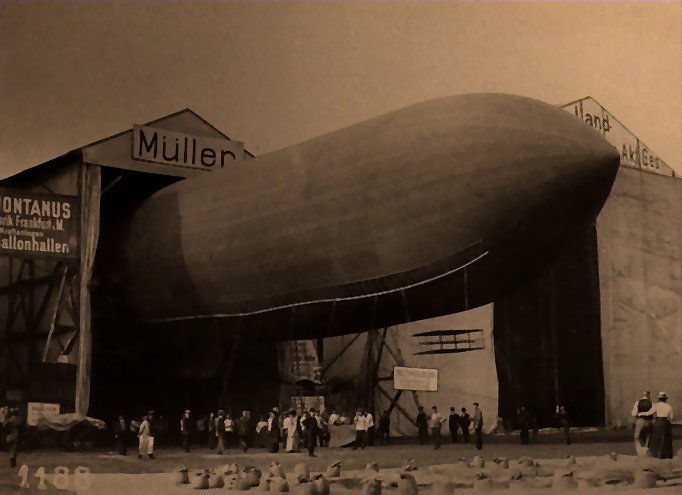 The hall
had a steel structure as a support with the advantage of an overall smaller
outer dimension compared to halls of wood or reinforced concrete and a smaller
wind attack area. The hall lining consisted of large interconnected metal
tracks. The hall
had a steel structure as a support with the advantage of an overall smaller
outer dimension compared to halls of wood or reinforced concrete and a smaller
wind attack area. The hall lining consisted of large interconnected metal
tracks.
The hall gate was a combined swivel and swing gate, that was a folding door
[87], which was inserted into a rectangular steel frame in front of the hall by
means of guide rollers. The combination of an internal swivel and an external
turntable was a technically sophisticated design. The drive of the hall gate
mechanism took place exclusively at the bottom of the inside of the rotary door,
the swinging door ran by itself. The passing airship thus received adequate wind
protection. Thus the most important task was to "open and close the halls in
a short time for the entry and exit of an airship" [88].

The entire building complex of the airship harbor ran as a spatial separation
from the surrounding terrain, a fencing in the form of a wall. Since the airship
was only a hall opening to the entrance and exit was available, approximately
one kilometer away from the hall a device for anchoring the airship was installed.
The ship could be installed there in the event of an unfavorable weather
situation, in order to drive it into the hall.
In August 1909 the "Reichsluftschiffhafen Cöln" [89] was opened and used as a
Zeppelin airport for military purposes.
The first order of the Lufschiffer battalion No. 1, which was now stationed in
the Cologne Reichslufthafen, was followed two years later by further units.
On October 1, 1911, both the seat of the staff and the 1st Company of the newly
formed Battalion No. 3 battalion were transferred to the cathedral city.
The unit was provisionally lodged at Bocklemünd, Fort IV of the Prussian
fortress ring around Cologne. [90]
In the following years, an air raid barracks was built at Frohnstraße 190 in
Cologne-Ossendorf.
Many
air traffic controllers joined the CCfL as active members.
Between the Luftschiffer battalion and the Cologne club, close contacts were
soon established, which meant that "in the early years" a successful
civil-military cooperation had been practiced "[91].
The friendly cooperation had the advantage for the association, for example,
that the CCfL balloons may have been filled free of charge with the light gas
discharged from the airship.
The unit, which had been renamed "Luftschiffer-Abteilung" since 1887, served as
a model for the Luftwaffe battalions, which were soon to be established, and the
later Lufschiffer battalions. "[190] Between 1909 and 1912,
Autumn airship maneuvers took
place. [93]
In addition to the Zeppelin airships, which were part of the rigid construction,
there were also the semi-armed airships of Major Hans Gross with the designation
'M' as well as the non-rigid impact airships with the designation 'P', which
were designed by Major August von Parseval . [94]
The aim of these maneuvers was the field trial of the military airships of all
three types of construction.
Above all it was about the determination of the achievable maximum height.
Observed were the test journeys of emissaries of the military commission of
the Prussian army administration.
One of the largest airship maneuvers was in Cologne from 25 October to 20
November 1909. [95]
The three military airships 'Z II', 'M II' and 'P II' as well as the private
airship 'P III' completed journeys of various kinds: speed, low and high rides
as well as formation, relay and night drives.
During the entire duration of the maneuver, the airship hall in Cologne-Bickendorf
was surrounded by spectators and rapporteurs from domestic and foreign
newspapers.
The last maneuvering of all four airships together took place on 6 November 1909
over Cologne.
The
spring maneuvers of 1910 began on the 7th of April.
In addition to the military airships 'Z II', 'M II' and 'P II', the Cologne
airship 'Clouth' and the 'Erbslöh' airship from Leichlingen also participated as
guests.
In the course of the maneuver 'Z II' stranded on 24 April 1910 near Weilburg a.
d. Lahn and was destroyed by a storm on the ground.
It had
torn itself out of its anchorage the day before.
The resulting damage to the airship was irreparable.
After a total of 16 journeys (2478 km) 'Z II' was scrapped. [96]
On November 23, 1911, the Zeppelin airfield 'Z II' [97] (LZ 9) transferred
personally from Friedrichshafen to Cologne reached the cathedral city.
The airship arrived with a considerable delay to the airship maneuver already
taking place since the beginning of November.
The military were disappointed by the results so far of the maneuvers, which
also included the military airship 'M II'.
Also the hope that the participation of '(replacement) Z II' would develop the
airship maneuvers better was not fulfilled due to the bad weather;
The maneuver ended in early
December.
In the opinion of the military, the successes were in no relation to the
expectations.
The airship '(replacement) Z II' was stationed in the fortress city of Cologne
after completion of the airship maneuver.
The status of the cathedral city as a fortified city and at the same time as the
location of a military airship port brought with it numerous problems for the
general civil aviation and in particular for the interests of the civilian
Cologne aviation.
Since 1911, the Cologne fortress governor had prohibited the city from flying
over and photographing the city. [98]
The background of the prohibition was the fear that by enemy agents the terrain
could be spied.
For example, the airship 'Ersatz-Deutschland' (LZ8) on its journey to Düsseldorf
on 12 April 1911 had to avoid the fortified city of Cologne.
The Zeppelin passenger airships were not permitted to fly over and landings
within the boundaries of the city.
Cologne was thus excluded from the new lines of DELAG air transport. [99]
The danger, however, that the CCfL would have to dissolve because of this
prohibition did not exist.
The fortress governor made a big concession to the members of the CCfL: In the
fortress area of Cologne they were still allowed to climb in the open air and
on the airplane. [100]
Thus, the exercise of the aerial sport within the cathedral city remained at
least for the members of the CCfL.
However, this exemption did not apply to private pilots or companies which
operate the aviation business.
During the course of 1911/12 the German military leadership recognized the
inadequate effectiveness of the airships as a weapon in the air warfare: "According
to the present situation, airships can do some service in the war of leadership,
less as a weapon than in the Enlightenment."
] At the beginning of 1912, the Ministry of War decided to accelerate the
construction of the Army Air Force group.
With a "national flight donation" the German citizens were called upon to
support the development of the aircraft financially.
From 1911 onwards, the Cologne military administration looked back on the
construction of a civilian airport and, in accordance with the plans of the
Ministry of War, pursued the construction of a military air base. [102]
1912 between the city of Cologne and the Reichsfiskus a contract concluded, the
lease and military use of a site at the Butzweiler Hof to 20 years.
The site "is particularly favorable because it is directly adjacent to the
military airship hall built in Ossendorf." [103] The military took over the
installation of the rolling-field and the construction of the airfield
facilities.
The city ensured the creation of a tram connection.
In order not to completely exclude a civilian use of the terrain, the CCfL
encouraged, in agreement with the commander of the air base station, to carry
out flight events on the pitch. [104]
On September 15, 1912, the foundation stone was laid for the military flying
station "Butzweiler Hof".
The military advance, which arrived on December 1, 1912, without airplanes in
Cologne, began with the first work on the installation and construction of a
military air station
III.
Concluding remarks
The historical history of the conquest of the airspace can be clearly
illustrated by the early history of aviation in Cologne;
It proves to be very versatile, so the different facets of the balloon can be
found, for example, as an attraction as well as a sports device; later it is the use of the airships for military purposes as well as the
beginning of the motor-yachting.
As early as the 18th century, only a few years after the successful start of a
Montgolfiere, the rise of a manned balloon can be demonstrated in Cologne. On
June 29, 1795, a military observation balloon was opened by French troops at the
gates of the city.
In the course of the 19th century,
numerous
balloon ascents took place in the cathedral city, such as by the airmen Sinval
and Guerin in 1808 and 1847 by the famous balloon driver Charles Green.
During this period, the French and English were the ones who visited the
cathedral city and show balloon ascents.
Spectacular balloon ascents took place at the end of the 19th century.
In the so-called
"golden corner" (Pub "Goldenes Eck") in Cologne-Riehl.
As a permanent attraction, the Aeronaut Maximilian Wolff ran balloon flights
with passengers for commercial purposes.
Around the turn of the
19th / 20th century,
The "Cölner Aero-Club", the later "Cölner Club für Luftschiffahrt e. V."
(Cologne's club for aviation) was celebrated in Cologne on November 6,
CCfL).
This laid the foundations for the development of aerial sports within the Rhine
metropolis.
In addition, Cologne was an important impetus for the development of balloon and
zeppelin technology: the Cologne-based company Clouth developed a steerable,
motor-driven airship (Dirigible) in 1907.
The airship hall built in this context can also be viewed as the first air
traffic architecture in Cologne.
 The
year 1909, with the "International balloon competition" and the
"International flight week", highlights the beginnings of Cologne's aviation
history.
This year, the citizens of Cologne was able to experience and admire aircraft
for the first time at such an event.
Venues Cologne's aerial sports activities were initially the site of today's
Aachener Weiher as well as the horse racing course in today's Cologne-Weidenpesch. The
year 1909, with the "International balloon competition" and the
"International flight week", highlights the beginnings of Cologne's aviation
history.
This year, the citizens of Cologne was able to experience and admire aircraft
for the first time at such an event.
Venues Cologne's aerial sports activities were initially the site of today's
Aachener Weiher as well as the horse racing course in today's Cologne-Weidenpesch.
In the same year, the military interests in aviation emerged in the fortified
city of Cologne in the founding and installation of an airship harbor in
Cologne-Bickendorf as well as the stationing of a military airship.
The airship hall erected here was one of the very first architectural features
of an air transport architecture in the Cologne city area and was also a
remarkable engineering achievement of this time.
In the following years, Cologne was location of numerous airship maneuvers.
Although the fortified character of the city was hampered by a further expansion
of the city's aerial sports by flying and photographing bans, there was
civil-military cooperation between the CCFL and the stationed battalion
battalion;
The inclusion of Cologne in a national airship network was prevented by the
military regulations.
1912
was the year of foundation for the military flight station "Butzweiler Hof"
and at the same time the starting point for all other aviation ambitions in
Cologne.
In summary, it should be noted that the events of the early years of Cologne
aviation were also revealing with regard to general aviation. The events of
civilian and military aviation, cited in Cologne, certainly document a very
small section of the general German aviation history. They were, however,
very representative, for they show the development of general aviation in
Germany up to the beginning of the twentieth century. comprehend.
[1]
ECKERT, Alfred: Zur Geschichte der Ballonfahrt. In: Leichter als Luft, 1978, S.
15–133, hier S. 67 (= Ausst.-Kat. Leichter als Luft. Zur Geschichte der
Ballonfahrt. 24.09.–26.11.1978 Westfälisches Landesmuseum für Kunst- und
Kulturgeschichte, bearb. von Bernard Korzus. Greven 1978). Eine Ausnahme unter
den deutschen Landesherren ist der wissenschaftlich interessierte Herzog von
Braunschweig. Auf dessen Veranlassung wird ein Gasballon konstruiert, der am
28. Januar 1784 in Braunschweig aufsteigt.
[2]
Vgl. ECKERT (1978), S. 67.
[3]
Vgl. ECKERT (1978), S. 84.
[4]
Vgl. ECKERT (1984), S. 84. Die Rundreise in Deutschland umfaßt insgesamt 10
Städte; weitere Stationen sind u. a.: Hamburg (23. August 1786), Leipzig (29.
September 1787), Nürnberg (12. November 1787), Braunschweig (10. August 1788),
Wien (9. März.1791, mißglückter Start); erst mit Blanchards Abreise nach
Amerika 1792 enden diese Vorstellungen.
[5]
Vgl. MAYER, Edgar, MÜLLER-AHLE, Monika: o. T. - Unveröff. Typoskript. o. D;
SUNTROP, Heribert: Der Butzweilerhof und die Kölner Luftfahrt. Chronik. Eine
Arbeitsgrundlage für die Geschichtsschreibung. Unveröff. Typoskript, Bd. 1.
2001.
[6]
Vgl. HAStK, Best. Ratsprotokolle, Nr. 232; MAYER, MÜLLER-AHLE (o. D.), S. 2.
[8]
Vgl. MAYER, MÜLLER-AHLE
(o. D.), S. 2.
[9]
Vgl. VOGT, Hans: Seidene Kugel und Fliegende Kiste. Eine Geschichte der
Luftfahrt in Krefeld und am Niederrhein. Krefeld 1993 (= Krefelder Studien, Bd.
7, hrsg. vom Stadtarchiv Krefeld), hier S. 11. Bereits Anfang 1785 erfolgt in
Düsseldorf ein Aufstieg einer Charlière.
[10]
Entweder handelt es sich um einen dreimaligen Aufstieg eines einzigen Ballons
oder um einen einmaligen Aufstieg von insgesamt drei Ballonen. Ob diese
Ballonaufstiege mit oder ohne menschliche Besatzung stattfinden, ist nicht mehr
eindeutig zu klären.
[11] Vgl.
Cölnischer Staatsboth, 13. Junius 1788, 73tes Stuck und 4. Julius 1788, 83tes
Stuck; MAYER, MÜLLER-AHLE (o. D.), S. 3.
[12]
Deutz ist Bestandteil der Stadterweiterung Kölns von 1888; erst seitdem ist es
Stadtteil der Rheinmetropole.
[13] Die Aussicht
auf wirtschaftlichen Profit durch zahlende Zuschauer scheint die anfänglich
ablehnende Haltung des Kölner Erzbischofs und Kurfürsten revidiert zu haben.
[14]
Vgl. Rheinischer Merkur, 24. Juli 1911; MAYER, MÜLLER-AHLE (o. D.), S. 3.
[15] ECKERT (1978), S. 86.
[16] ECKERT (1978), S. 105.
[17] Vgl. Gazette de Française de Cologne, 20.
April 1808, 8. Mai 1808, 14. Mai 1808; Der Verkündiger 24. April 1808,
Nr. 581, 1. Mai. 1808, Nr. 583; MAYER, MÜLLER-AHLE (o. D.), S. 7.
[18]
Vgl. ECKERT (1984), S. 104; MACKWORTH-PRAED, Ben: Pionierjahre der Luftfahrt.
Stuttgart 1993, hier S. 54. Charles Green (1785-1870) gehört zu den
berühmtesten Ballonfahrern seiner Zeit. Ihm sollen über fünfhundert Aufstiege
gelungen sein. Besondere Verdienste kommen ihm für die Weiterentwicklung des
Ballons durch Einführung des Kohlenstoffgases zu. Green beschränkte sich in
seiner Luftfahrertätigkeit nicht ausschließlich auf Schaufahrten, sondern
verband damit auch wissenschaftliche Ambitionen.
[19]
Vgl. Rheinischer Beobachter, 2. Mai 1847, Nr. 153; MAYER, MÜLLER-AHLE (o. D.),
S. 7.
[20]
Vgl. HStA Düsseldorf, Best. Polizeipräsidium Köln, Nr. 49 (Schreiben von
Gustave Landreau an den Polizeipräsidenten von Köln vom 19. März 1878); MAYER,
MÜLLER-AHLE (o. D.), S. 7.
[21] Vgl. HOHMANN,
Ulrich: Beiträge zur Geschichte des Ballonsportes in Deutschland. Die Zeit von
1900 bis 1939, Bd. 1 (hrsg. vom Deutschen Freiballonsport-Verband e. V.). o. O.
1993, hier S. 8. Später wird der Verein in „Berliner Verein für Luftschiffahrt
e. V.“ umbenannt.
[22]
Vgl. HStA Düsseldorf, Best. Polizeipräsidium Köln, Nr. 49 (Briefkopf eines
Schreibens bzw. Schreiben von Maximilian Wolff an den Polizeipräsidenten von
Köln, 6. Juni 1889 und 7. Juni 1890); MAYER, MÜLLER-AHLE (o. D.), S. 8.
[23]
Der sog. altkölnische Festplatz zwischen Flora und dem zoologischen Garten wird
vom Volksmund wegen der vielen Vergnügungsgärten das „Goldene Dreieck“ genannt.
[24]
Vgl. DIETMAR, Carl: Die Chronik Kölns. Dortmund 1991, hier S. 273. Die
Ausstellung dauert vier Monate an und findet im Vergnügungspark „Kaisergarten“
des „Goldenen Dreiecks“ statt.
[25]
Vgl. Kölner Local-Anzeiger, 11. Juni 1889, Nr. 56; MAYER, MÜLLER-AHLE (o. D.),
S. 9.
[26]
Die Ausstellung dauert vom 16. Mai bis 15. Oktober 1889 an und findet im
heutigen nördlichen Teil des Zoologischen Gartens, in Nähe der Flora, statt.
[27]
Vgl. Kölner Local-Anzeiger, 11. Juni 1889, Nr. 56; MAYER, MÜLLER-AHLE (o. D.),
S. 9.
[28]
Vgl. Kölnische Nachrichten, 9. Juli 1890, Nr. 154; MAYER, MÜLLER-AHLE (o. D.),
S. 10.
[29]
Vgl. SUNTROP (2001), S. 9; Diese Ereignisse vom 7. Juli 1890 werden in 27
weiteren Zeitungen in ganz Deutschland veröffentlicht.
[30]
Vgl. HStA Düsseldorf, Best. Polizeipräsidium Köln, Nr. 49; MAYER, MÜLLER-AHLE
(o. D.), S. 11.
[31] Vgl. SUNTROP (2001), S. 10.
[32] Vgl. VOGT (1993), S. 24–32.
[34]
Vgl. Rheinisch-Westfälische Zeitung, Nr.1238, 27. Juni 1910; MAYER, MÜLLER-AHLE
(o. D.), S. 8.
[35] Vgl. MACKWORTH-PRAED (1993), S. 83.
[36] Vgl. FRANZ CLOUTH. RHEINISCHE
GUMMIWARENFABRIK AG (Hrsg.): 90 Jahre Franz Clouth. 1862-1952. Köln o. D., hier
S. 13. Die Firma Clouth liefert u. a. 1899 den Ballonstoff für das erste
Luftschiff des Grafen Zeppelin ‘LZ 1’.
[37]
Vgl. FRANZ CLOUTH (o. D.), S. 14. Der Bau besteht mindestens bis 1912. Aus
welchem Material die Halle besteht, ist nicht zu sagen; sie brennt Jahre später
ab.
[38]
Vgl. CLOUTH GmbH, Firmenarchiv, Liste der Zeitungsartikel im Zusammenhang mit
der Brüsselfahrt des Luftschiffes ‘Clouth’ vom 20. Juni 1910. An dieser Stelle
bedankt sich der Autor bei Herrn Wolfgang Beier, der u. a. das Archiv der
„Clouth GmbH“ leitet, für seine Hilfe und zahlreichen Hinweise.
[39]
Vgl. CLOUTH GmbH, Firmenarchiv (Liste der angefertigten Bauteile). Einige
Dokumente im Archiv der Firma „Clouth“ belegen jedoch die Absicht vom Bau eines
zweiten Luftschiffes. Obwohl bereits verschiedene Bauteile angefertigt wurden,
wurde die Konstruktion anschließend nie abgeschlossen.
[40]
Vgl. FRANZ CLOUTH (o. D.), S. 13.
[41]
MAYER, MÜLLER-AHLE (o. D.), S. 12.
[42]
MACKWORTH-PRAED (1993), S. 51.
[43]
MAYER, Edgar: Glanzlichter der frühen Luftfahrt in Köln. 75 Jahre
Butzweilerhof. Oldenburg 2001 (= Luftfahrtgeschichte von Köln und Bonn, Bd. 1,
hrsg. von der Fördergesellschaft für Luftfahrtgeschichte im Kölner-Raum e. V.),
hier S. 89.
[44]
HOHMANN (1993), S. 12.
[45]
Vgl. HOHMANN (1993), S. 53. Dort ist eine nach dem jeweiligen Gründungsdatum
chronologisch angeordnete Liste der Vereine (bis 1910) zu finden.
[46]
Vgl. HOHMANN (1993), S. 11; VOGT (1993), S. 32–36.
[47]
Vgl. KÖLNER KLUB FÜR LUFTSPORT e. V. (Hrsg.): Festschrift zum 75jährigen Bestehen
des Kölner Klub für Luftsport e. V. Köln o. D, hier S. 17.
[48]
Vgl. MAYER, MÜLLER-AHLE (o. D.), S. 14; KÖLNER KLUB FÜR LUFTSPORT e. V. (o.
D.), S. 17.
[49]
HOHMANN (1993), S. 12.
[50]
Vgl. HOHMANN (1993), S. 120/121.
[51]
Vgl. STADE, Hermann (Hrsg.): Jahrbuch des Deutschen Luftschiffer-Verbandes
1911. Berlin 1911, hier S. 150/151.
[52]
Vgl. HOHMANN (1993), S. 53.
[53]
MAYER (2001), S. 18.
[54]
Preise, jeweils Tageskarte: Korbplatz/Herren 10, Damen 8 und Kinder 4 Mark;
Promenadenplatz/5, 3 und 1,50 Mark; Rasenplatz/alle 0,75 Mark. Der Stundenlohn eines beispielsweise Kohlentransportarbeiters beträgt 0,43
Mark.
[55]
Vgl. Rheinische Zeitung, 22. Juni 1909, Nr. 141 und 26. Juni 1909, Nr. 145;
MAYER, MÜLLER-AHLE (o. D.), S. 17.
[56]
Vgl. das „Fest-Programm zur grossen internationalen Flug-Woche, Cöln am Rhein
vom 30. September bis 6. Oktober 09“.
[57]
Bisweilen ist auch die Schreibweise mit doppeltem „e“ – „Meerheim“ sowie mit
„h“ – „Mehrheim“ – zu finden.
[58]
Blériots Geschwindigkeitsrekord liegt bei ca. 60 km/h.
[59]
Die erste bedeutende Veranstaltung findet am 23. Mai 1909 auf dem Flugfeld
Port-Aviation, südlich von Paris, statt.
[60]
In Johannisthal, südöstlich von Berlin, werden 1909 bzw. 1908 beispielsweise
von den Pferderennbahnen Holztribünen übernommen; in Brookland/England finden
ab 1909 die Flugschauen unweit der 1907 gebauten Rennstrecke statt.
[61]
GÄRTNER, Ulrike: Flughafenarchitektur der 20er und 30er Jahre in Deutschland.
Diss. Marburg/Lahn 1990, hier S. 11: „Inoffiziell beschäftigte sich aber auch
das deutsche Militär seit 1909 mit der Konstruktion eines Flugzeugs.“
[62]
Eine eingehende Darstellung der Kölner Flugpioniere kann im Rahmen der
vorliegenden Ausführungen nicht geleistet werden. Dazu bedarf es einer
eigenständigen Schilderung, um diesem Kapitel Kölner Luftfahrtgeschichte gerecht
zu werden.
[63]
Die Veranstaltung beinhaltet Preise in Höhe von 100000 Mark, gestiftet von der
Berliner Zeitung/Ullstein-Verlag, sowie Geldpreise des Preußischen
Kriegsministeriums, von Flugsportvereinen, Städten und Gemeinden. Bei dieser
Veranstaltung, bei der nur deutsche Flieger zugelassen sind, werden insgesamt
13 Tagesetappen mit 1854 km zurückgelegt.
[64]
Vgl. DIETMAR (1991), S. 228. Zu Beginn der preußischen Herrschaft wird Köln von
König Friedrich Wilhelm III. zur Festung erklärt.
[65]
Vgl. SUNTROP (2001), S. 54. Die Stadt beabsichtigt den bestehenden Pachtvertrag
mit dem Landwirt des Butzweiler Hofs zu kündigen, um
das Feld uneingeschränkt für die Fliegerei zur Verfügung zu stellen.
[66]
Vgl. SUNTROP (2001), S. 60.
[67]
Vgl. SUNTROP (2001), S. 65.
[68]
Vgl. THIEME, Ulrich, BECKER, Felix: Allgemeines Lexikon der bildenden Künstler,
22. Bd. (Krügner-Leitch). Leipzig 1928, S. 377. Bei dem Künstler handelt es
sich vermutlich um Franz Xaver Laporterie (geb. 1754 in Bonn, gest. ?), dem ersten Sohn von Peter Laporterie. Franz Xavers
künstlerische Tätigkeit in Köln - vorwiegend als Stecher - ist dort seit 1780
bezeugt.
[69]
Vgl. HAStK, Best. Franz. Verw., Nr. 5012; MAYER, MÜLLER-AHLE (o. D.), S. 4.
[70] Vgl. LOCHER,
Walter: Militärische Verwendung des Ballons. In: Leichter als Luft, 1978, S.
238–250, hier S. 238 (= Ausst.-Kat. Leichter als Luft. Zur Geschichte der
Ballonfahrt. 24.09.–26.11.1978 Westfälisches Landesmuseum für Kunst- und
Kulturgeschichte, bearb. von Bernard Korzus. Greven 1978).
[71]
LOCHER (1978), S. 243.
[72]
Vgl. SUNTROP (2001), S. 3. Der „Revue- und Schiessplatz“ Wahner Heide wird im
Frühjahr des Jahres 1817 auf Weisung des preußischen Königs Friedrich Wilhelm
III. angelegt. In den nachfolgenden Jahren wird der Übungsplatz immer wieder
vergrößert.
[73]
Zur allgemeinen Kennzeichnung der deutschen Luftschiffe: LZ =
Zeppelin-Luftschiff; PL = Parseval-Luftschiff. Militärluftschiffe tragen
zunächst ein „Z“, später zusätzlich ein „L“ vor der Ordnungsnummer.
[74]
Vgl. SCHMITT, Günter: Als die Oldtimer flogen. Die Geschichte des Flugplatzes
Johannisthal. Berlin (DDR) 19872, hier S. 16.
[75]
Vgl. SUNTROP (2001), S. 18.
[76]
Die Gründung der „Deutschen Luftschiffahrts AG Frankfurt a. M.“ (DELAG) erfolgt
am 16. November 1909.
[77]
ENGBERDING, Dietrich: Luftschiff und Luftschiffahrt in Vergangenheit, Gegenwart
und Zukunft. Berlin 1926, hier S. 239.
[78]
MAYER, MÜLLER-AHLE (o. D.), S. 28.
[79]
Diese Fahrt ist der dritte Versuch, Köln zu erreichen; am 2. bzw. 4. August
musste ‘LZ 5’ wegen schlechten Wetters bzw. eines technischen Defekts
unfreiwillig die Rückfahrt antreten.
[80]
DIETMAR (1991), S. 313.
[81] Vgl. SONNTAG,
Richard: Über die Entwicklung und den heutigen Stand des deutschen
Luftschiffhallenbaus. In: Zeitschrift für Bauwesen, Heft 62, 1912, S. 571–614,
hier S. 599.
[82]
Ein Wettbewerb, der die Gestaltung einer Luftschiffhalle klären sollte, wurde
im Oktober 1908 in Deutschland ausgeschrieben; der Entwurf der
Brückenbauanstalt „Augsburg-Nürnberg AG“ erhält den dritten Preis.
[83]
Vgl. SUNTROP (2001), S. 25.
[84]
SONNTAG (1912), S. 574.
[85]
SONNTAG (1912), S. 574.
[86]
Vgl. Endnote 37. Formal ist die Luftschiffhalle in Bickendorf
durchaus mit der Luftschiffhalle der Firma Clouth von 1907 vergleichbar.
[87]
Vgl. SONNTAG (1912), S. 596.
[88]
SONNTAG (1912), S. 582. Die Dauer des Vorgangs ‘Öffnen/Schließen’ einer
Luftschiffhalle mit maschinenbetriebener Hallenöffnung betrug damals ca. 15
Minuten.
[89]
Vgl. VON TSCHUDI, Georg: Luftschiffhäfen, Ankerplätze und Flugplätze. In:
Deutsche Luftfahrer-Zeitschrift, Nr. 15, Jg. XVI, 1912, S. 361-364, hier S.
362. Eine Auflistung aller bis einschließlich 1912 existierenden
Luftschiffhallen, Flugplätze, Flugfelder und Landungsplätze in Deutschland ist
dort zu finden.
[90] Vgl. SUNTROP (2001), S. 53.
[91] MAYER (2001), S. 15.
[92]
MAYER, MÜLLER-AHLE (o. D.), S. 22.
[93]
Vgl. MAYER, MÜLLER-AHLE (o. D.), S. 22–24.
[94]
Vgl. MACKWORTH-PRAED (1993), S. 140.
[95]
Vgl. Kölner Stadt-Anzeiger, Nr. 494/495, 28./29. Oktober 1909 sowie Nr.
505–507, 4.–6. November 1909; MAYER, MÜLLER-AHLE (o. D.), S. 23; SUNTROP (2001),
S. 34.
[96]
Vgl. KNÄUSEL, Hans G. (Hrsg.): Zeppelin. Aufbruch ins 20. Jahrhundert. Bonn
1988, S. 161.
[97]
Vgl. KNÄUSEL (1988), S. 163. ‘(Ersatz-)Z II’ ist die offizielle
Betriebsbezeichnung des Luftschiffes.
[98]
Vgl. SUNTROP (2001), S.44 u. 52.
[99] Vgl.
Kölner Stadt-Anzeiger, 1. Mai 1912, Nr. 199; MAYER, MÜLLER-AHLE (o. D.), S. 30.
[100]
Vgl. SUNTROP (2001), S. 49. Die Erlaubnis ist an die Bedingung geknüpft, dass
fotografische Apparate nicht mitgeführt werden dürfen. Zudem muss zu jedem
Aufstieg ein Vorstandsmitglied des CCfL anwesend sein.
[101]
VON KLEIST, Ewald: Militär und Luftschiffahrt. In: Wir Luftschiffer, 1909, S.
285–306, hier S. 306.
[102]
Vgl. VON TSCHUDI (1912) S. 362/363. Im Jahr 1911 sind bereits in u. a. in
Straßburg und Metz Militär-Fliegerstationen errichtet worden.
[103]
SUNTROP (2001), S. 65.
[104] TÜRK, Oskar:
Der Flughafen Köln in der Geschichte der Kölner Luftfahrt. In: Deutsche
Flughäfen, Heft 6/7, 4. Jg., 1936, S. 7–15, hier S. 10.
Timeless Aviation?


Clouth Series 1; 1st steerable airship
The first flight objects, which were
created as balloons or as a zeppeline, were initially completely wind dependent,
so wind directions had to be taken into account as part of the launch, if one
wanted to achieve a certain goal. There were therefore no steering possibilities.
Franz Clouth had obviously thought about it and, together with his engineers,
built the first steerable airship, which was still basically wind driven, but in
principle allowed changes in direction by steering. This was made possible not
only by the side-rudder, but also by the engine.
The Franz Clouth balloon factory in Cologne built a small airship, which was
exhibited at the ILA (Internationale Luftfschiffahrts-Ausstellung) in Frankfurt
am Main in 1909.
It could be quickly assembled and dismantled, so it seemed to be very useful for
military purposes. Apart from guides and machinists it could take four persons
on board, as well as fuel for about 10 flight hours. This model was bought by
clubs and clubs. The airship made its maiden voyage to the International
Air Navigation Exhibition (ILA) in 1909 to Frankfurt and proved its special
maneuverability. At the same time, the hussars were unintentionally stepping
into the streets of Frankfurt and, without suffering any damage or injury, to
pass between the houses, to rise again to their proud heights. Because of this
elegant achievement, the Cloudian airship was called the "family carriage of the
future".

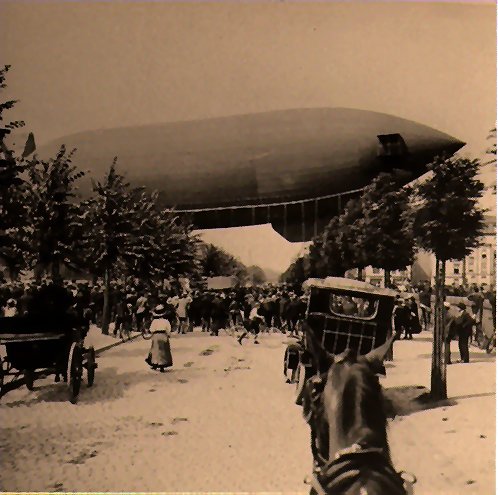
Airship Commander Richard Clouth
(with beard and cap) Forced landing in the streets of Frankfurt

Forced landing while International
Airship Exhibition 1909
The astonishment was
also great when the airship, controlled by Hauptmann von Kleist, appeared on
June 21, 1910, at the International Industrial Exposition in Brussels. It had
taken five hours for the 200-kilometer stretch. The Brussels and many other
foreign newspapers appreciated the event in detailed articles. In 1910 the
department "Luftschiff-Bau" (Air Ship Building) with the Aircraft Company mbH.
In Berlin after Clouth had built a second steerable airship after half-armed
system "Parseval", both of which were the property of the Berlin company, and
the Golden Medals are the remaining awards for Clouth's success in the airship

Balloons

First alpine crossing of a fetlock balloon by Cliff's "Sirius" fetter
ballon




CLOUTH IX and
Balloonticket
.jpg)
CLOUTH IX crossed
the Alpes as first balloon
The
Hindenburg Desaster

Possibilities of a Zeppelin seemed to be almost unlimited possible at that time.
One saw in them the future until a disaster with the Zeppelin Hindenburg
happened unexpectetly, which should make the success prospects of the employment
of Zeppelins impossible for the foreseeable future. At the same time, the
aviation industry developed by aircraft, the balloons and zeppelins seemed to be
more and more displaced as possible applications
_____________________________________________________
Revival of
Zeppelin-Technics

Massive Transporters
of nowadays
Von Evers, Marco
Is the Zeppelin
returning?
Companies such as the Arming Company Lockheed Martin are developing gigantic
airships for freight transport.
For a long time it has been the time of the big
airships.
It ended no later than May 6, 1937, when the 245-meter "Hindenburg" exploded
during the landing in the USA.
It was not until the turn of the millennium that the
once-proud industry once again drew a breath of life.
The German company Cargolifter developed a huge airship
for heavy loads.
It should be strong enough to hoist half an oil rig from
ocean to ocean.
But the bankruptcy came faster than the prototype;
Technically and financially the company had taken over.
Now a number of stragglers are trying on the Cargolifter
idea.
If they are successful this time, a new era of airships could actually start.
Silent, high-tech giants could soon fly machines or
containers through the air - cleaner and cheaper than
aircrafts or helicopters.
German manufacturers are not present at the current
Zeppelin revival.
Near Los Angeles, Aeros is building an aircraft of
almost 200 meters in length, which is designed to launch
and land vertically and move 66 tonnes of cargo.
It will be ready in five years at the earliest.
In England the competitor "Airlander 10" is to take off
in a test flight next spring.
This airship was once designed for the US forces, but
then fell victim to savings.
A small UK company wants to accomplish it by means of
crowdfunding and grants from the European Union.
DER
SPIEGEL 44/2015
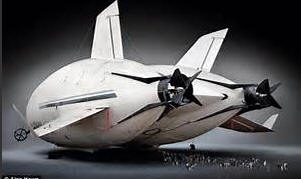
Ballooning and zeppelins are nowadays used in
numerous areas of life. This is not only in civilian deployments, but also in
military, although balloons and airships are much slower than aircraft and
missiles.
Clouth, demolished in 2015, no longer play a role, but Conti-Tech, which
continues to market the sphere of balloon and airships as a fillet from the then
acquisition.
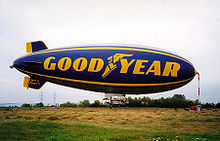
So-called blimp (impact airship without
internal scaffolding) without internal scaffolding like the rigid airships
German Edition: Made in Cologne,
Clouth and aviation
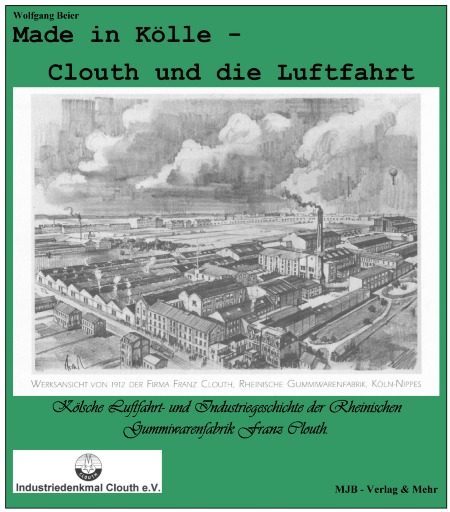
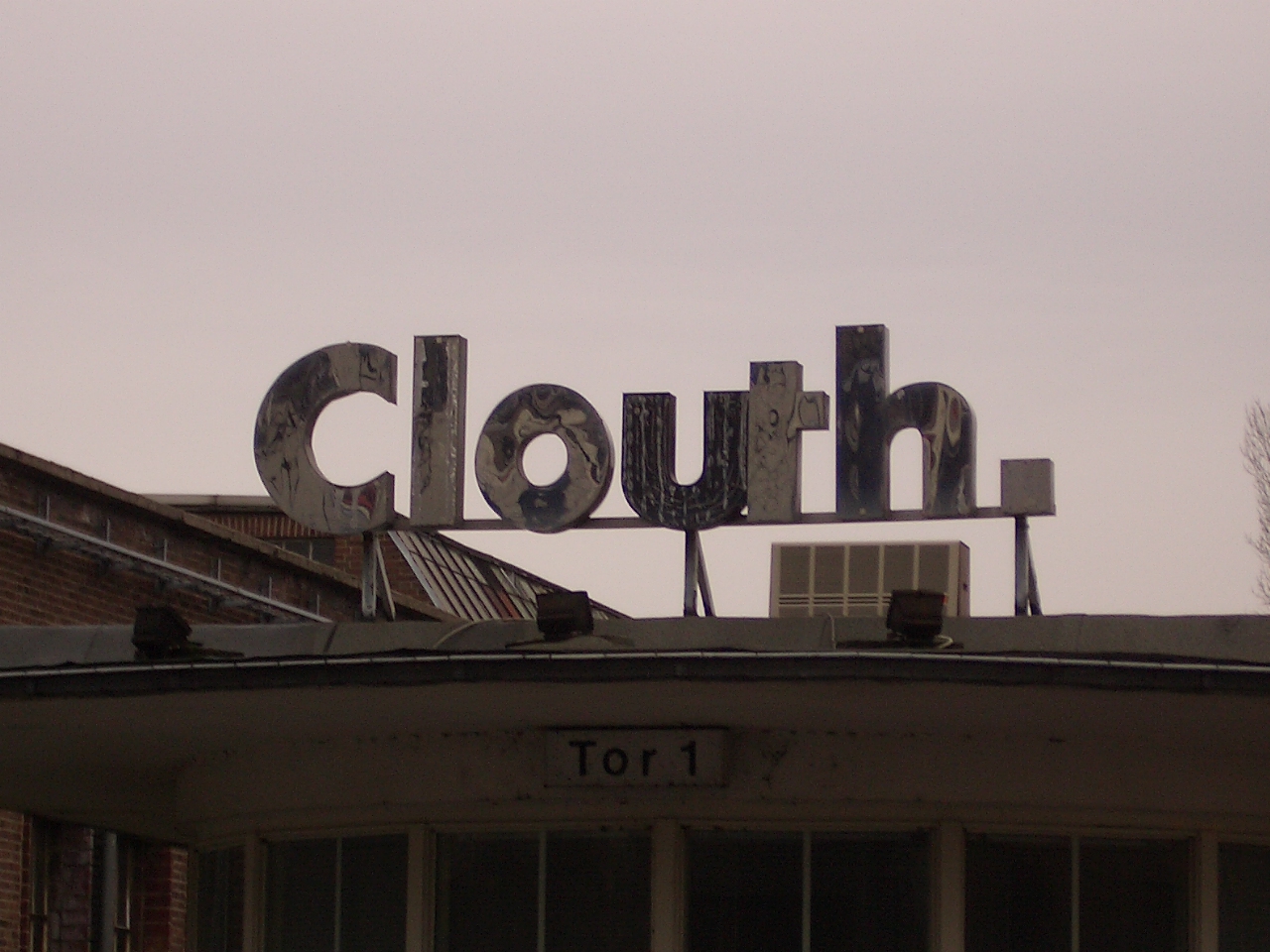

 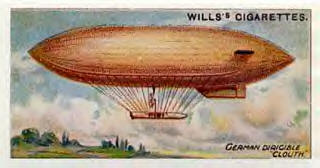




Franz Clouth
Family
coat of arms Clouth Cologne, registered in the German coat of arms registry 1923 Sun
Max Clouth

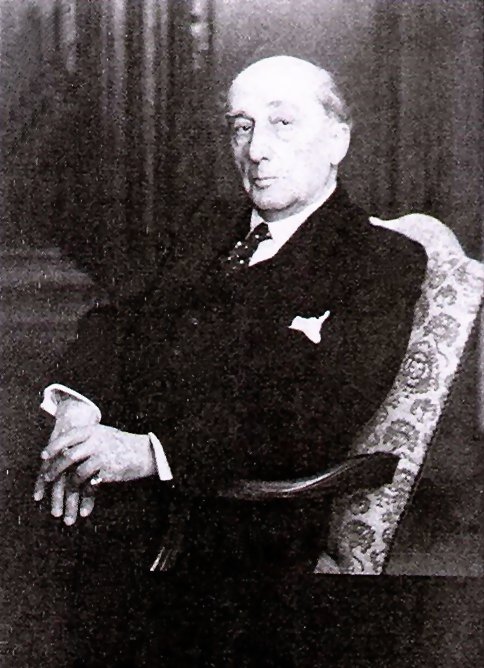
Clouth VIII
Max Clouth

Butzweiler Hof Airport




Balloon "Clouth 8"
Balloon gas valve front
Balloon Gas valve inside balloon



Balloone basket Advertisement France
Advertisement Germany


Clouth Book 1st Edition
2nd Edition

Clouth Works 1899
|













































.jpg)















 The
Cologne-based manufacturer Franz Clouth made an important contribution to both
the Cologne and the general development of aviation as well as the urban
industrialization process with his company "Franz Clouth Rheinische
Gummiwarenfabrik Cöln-Nippes".
The
Cologne-based manufacturer Franz Clouth made an important contribution to both
the Cologne and the general development of aviation as well as the urban
industrialization process with his company "Franz Clouth Rheinische
Gummiwarenfabrik Cöln-Nippes".  Cloudsche Luftschiff could be visited at the "Internationale
Luftschiffahrts-Ausstellung" (ILA) in Frankfurt/Main, next to constructions of
Zeppelin, Parseval and Ruthenberg.
Cloudsche Luftschiff could be visited at the "Internationale
Luftschiffahrts-Ausstellung" (ILA) in Frankfurt/Main, next to constructions of
Zeppelin, Parseval and Ruthenberg.  For Cologne, the CCfL, founded in 1906, was the decisive starting point and
basis for a subsequent decades-long history of ballooning and aerial sports in
the city.
For Cologne, the CCfL, founded in 1906, was the decisive starting point and
basis for a subsequent decades-long history of ballooning and aerial sports in
the city.  Decisively determined by
Ferdinand Graf (Count) von Zeppelin, using airships is carried
out at the beginning of the 20th century.
Decisively determined by
Ferdinand Graf (Count) von Zeppelin, using airships is carried
out at the beginning of the 20th century.  In
the late summer of 1909, the Zeppelin fever reached the cathedral city.
In
the late summer of 1909, the Zeppelin fever reached the cathedral city.  The airship hall of the Cologne airship harbor was designed as a 'driving and
rescue hall'.
The airship hall of the Cologne airship harbor was designed as a 'driving and
rescue hall'.  The hall
had a steel structure as a support with the advantage of an overall smaller
outer dimension compared to halls of wood or reinforced concrete and a smaller
wind attack area. The hall lining consisted of large interconnected metal
tracks.
The hall
had a steel structure as a support with the advantage of an overall smaller
outer dimension compared to halls of wood or reinforced concrete and a smaller
wind attack area. The hall lining consisted of large interconnected metal
tracks.








.jpg)








